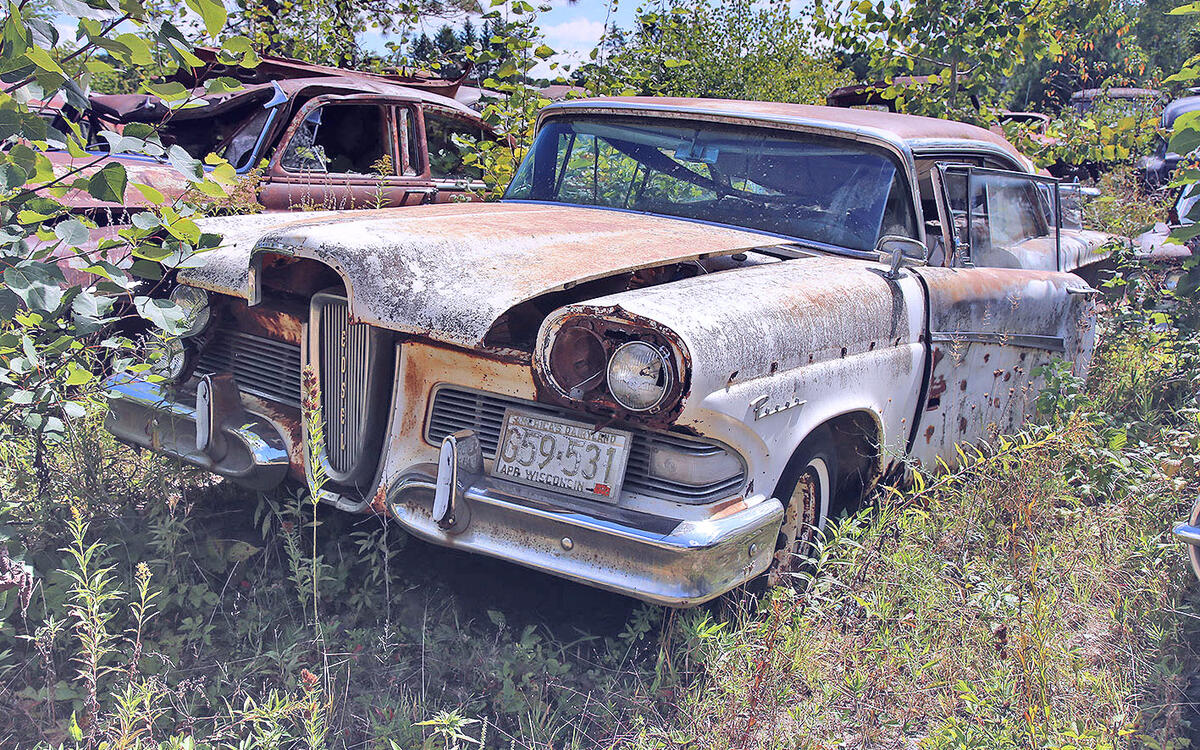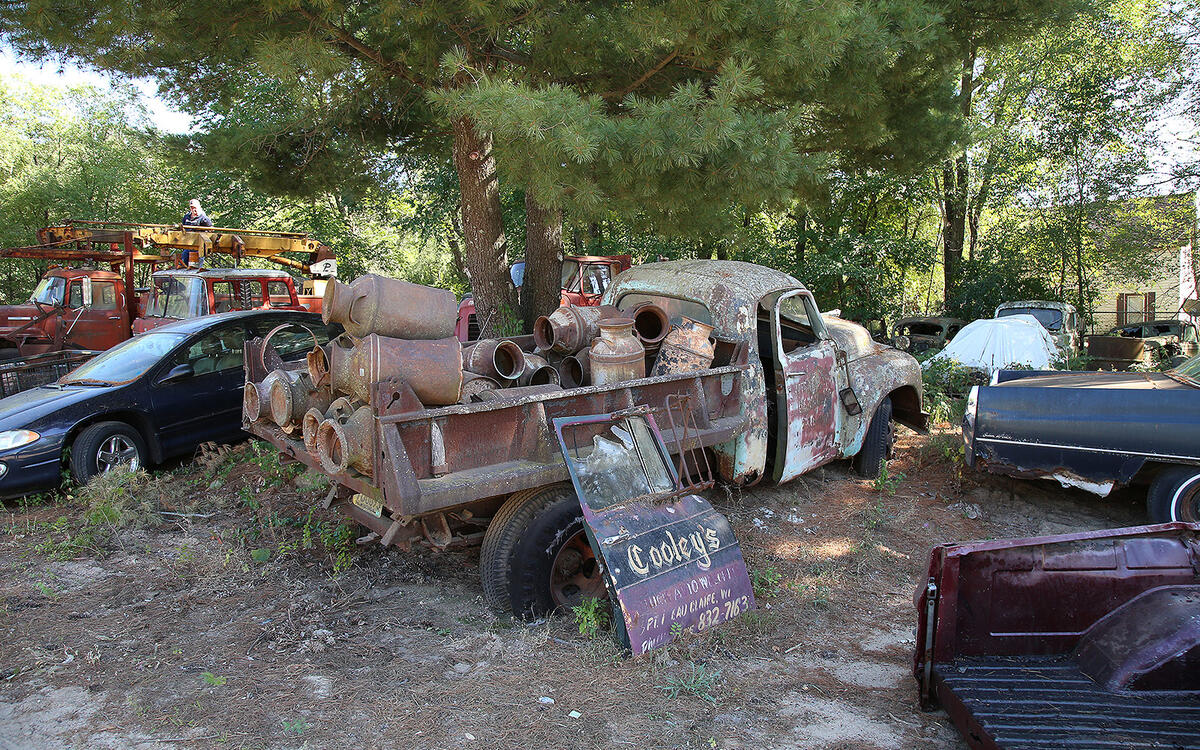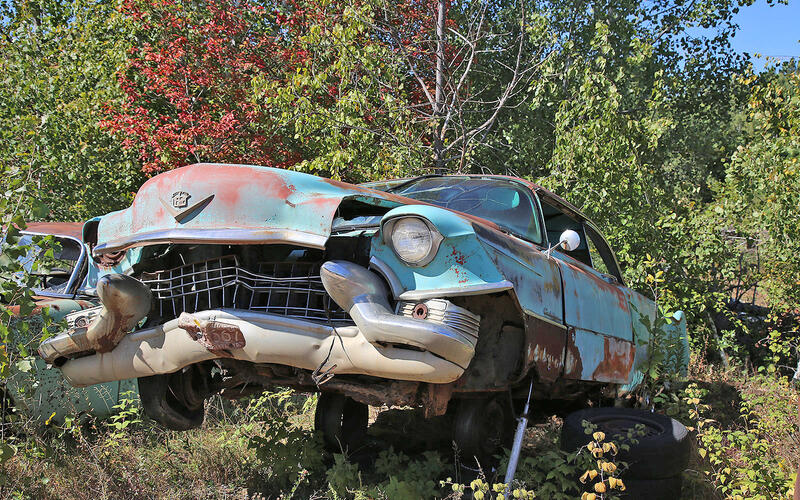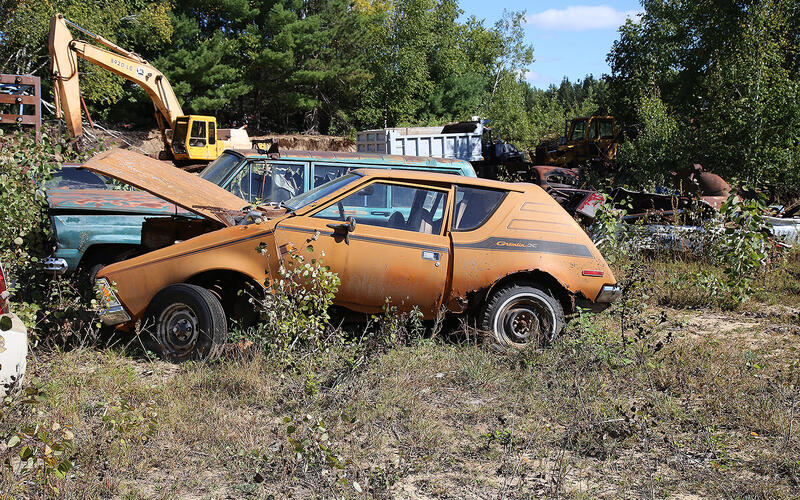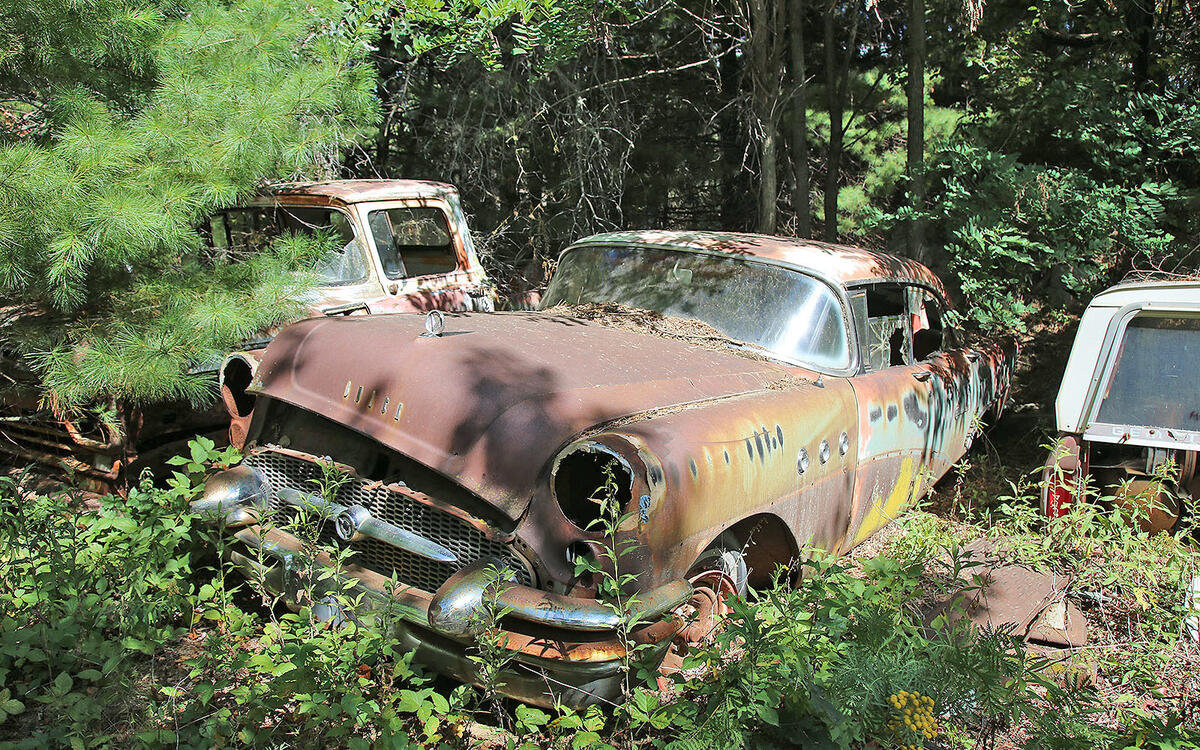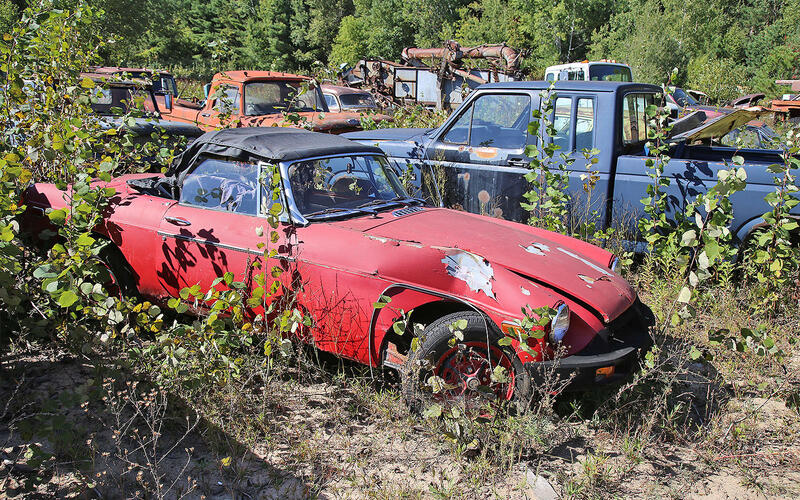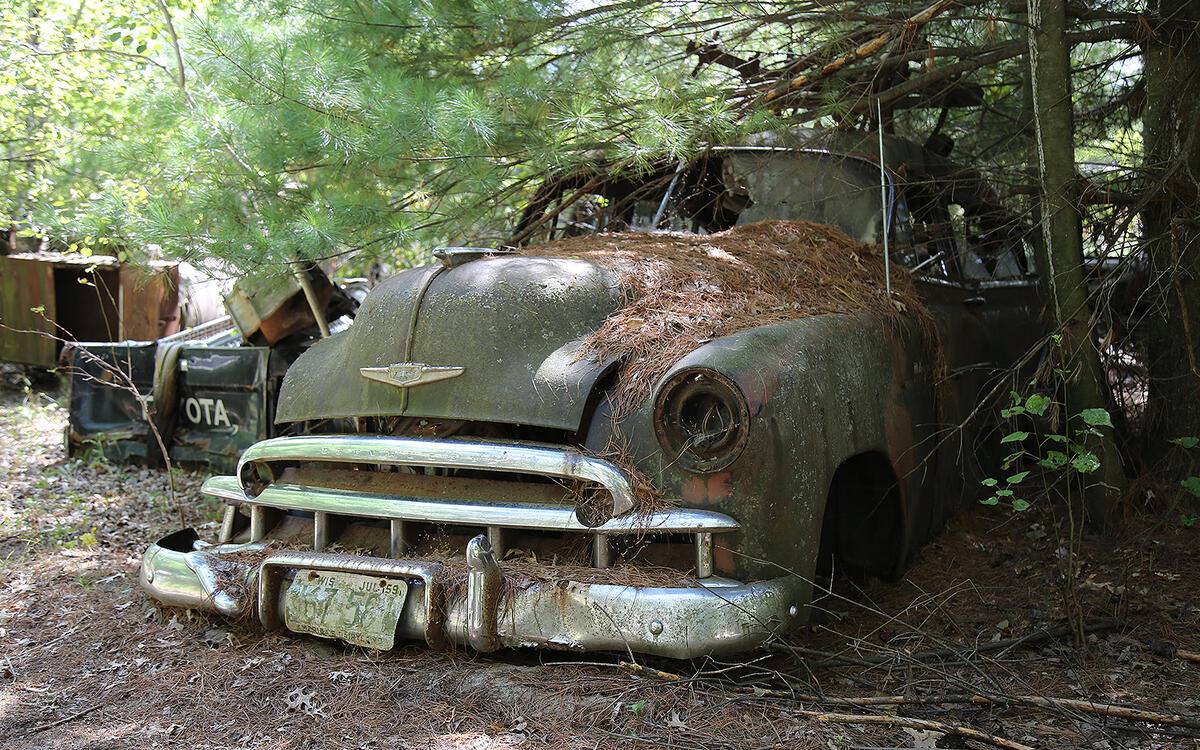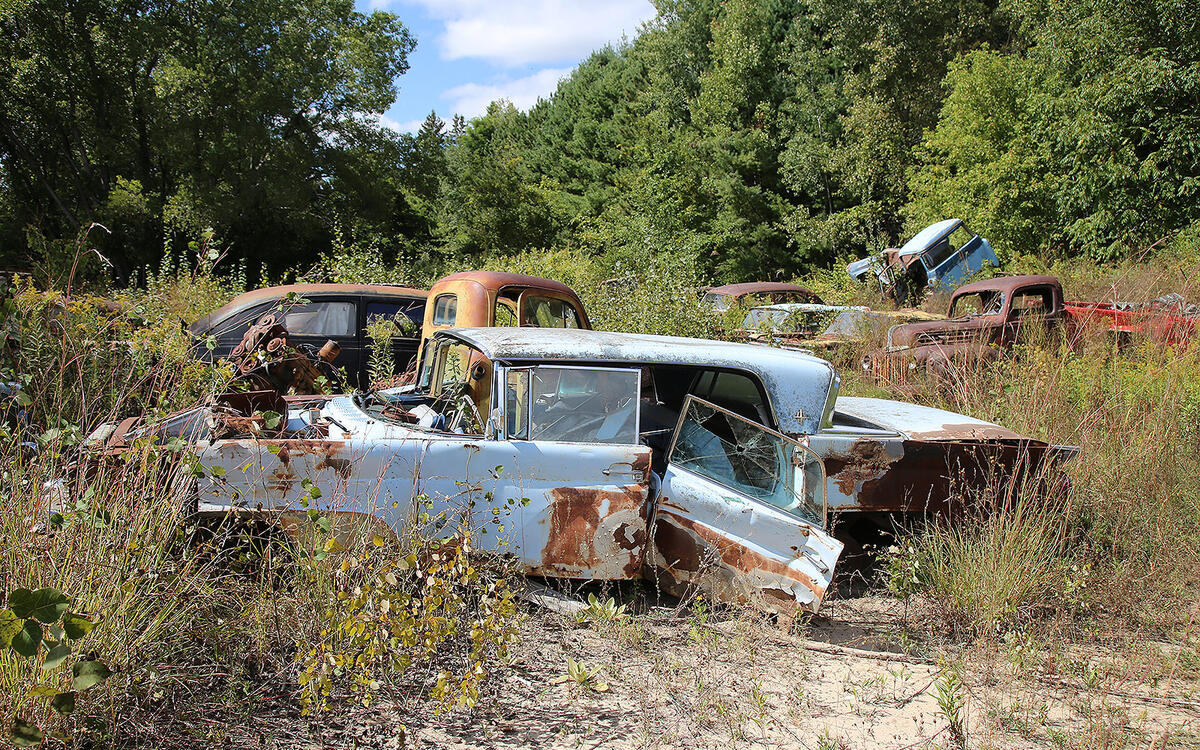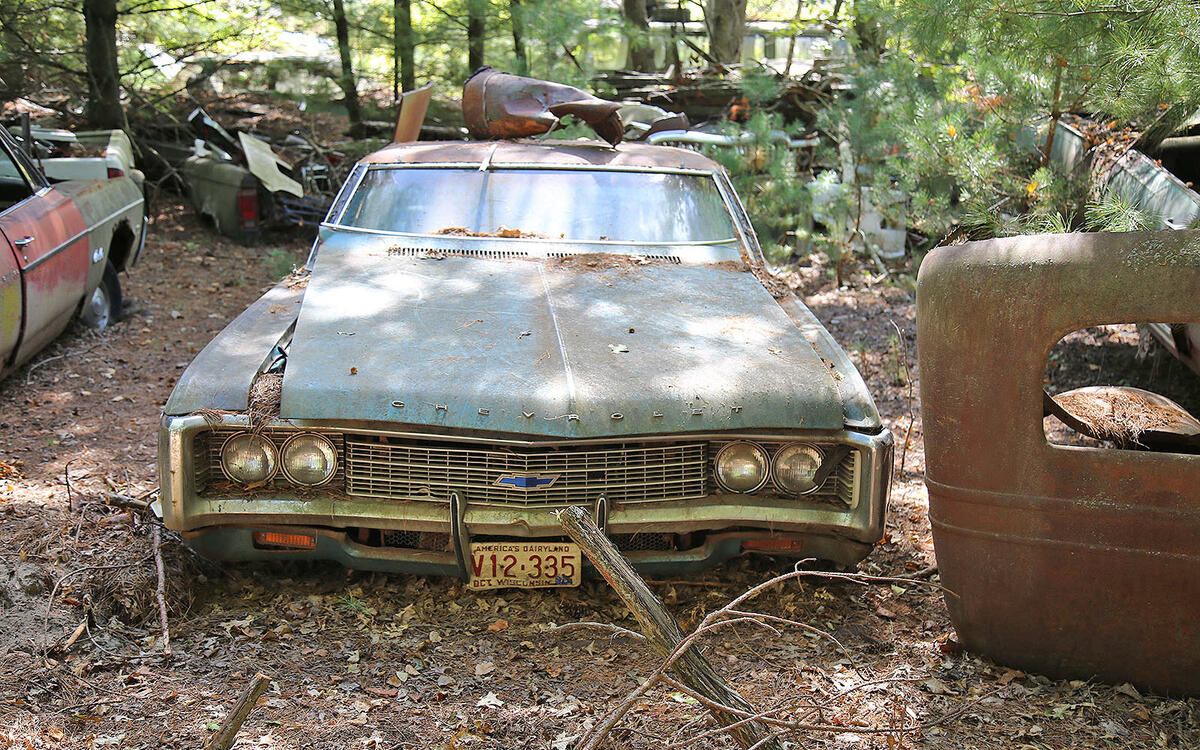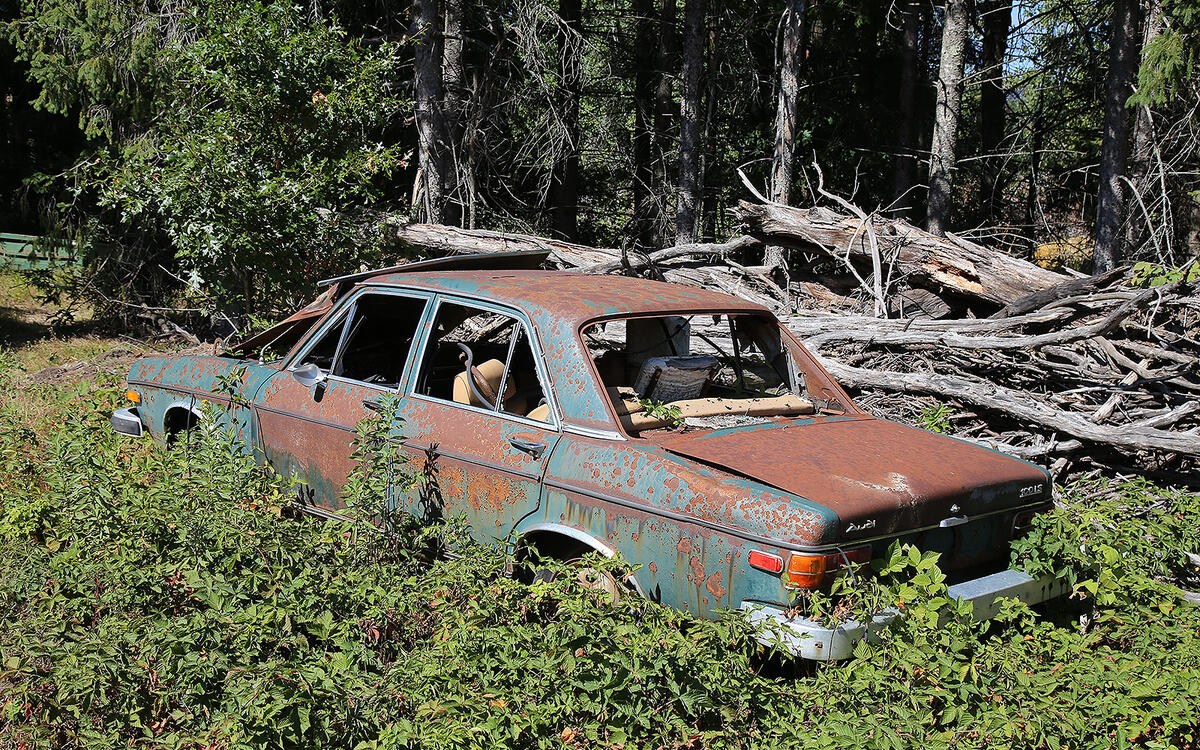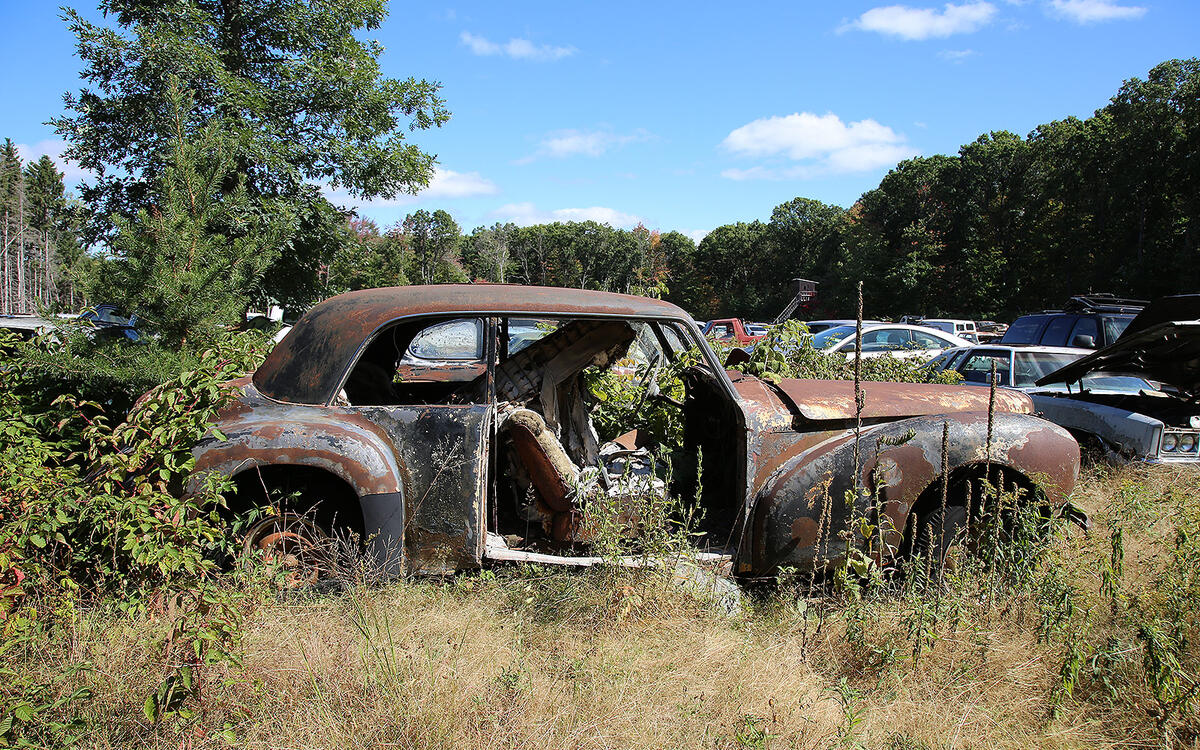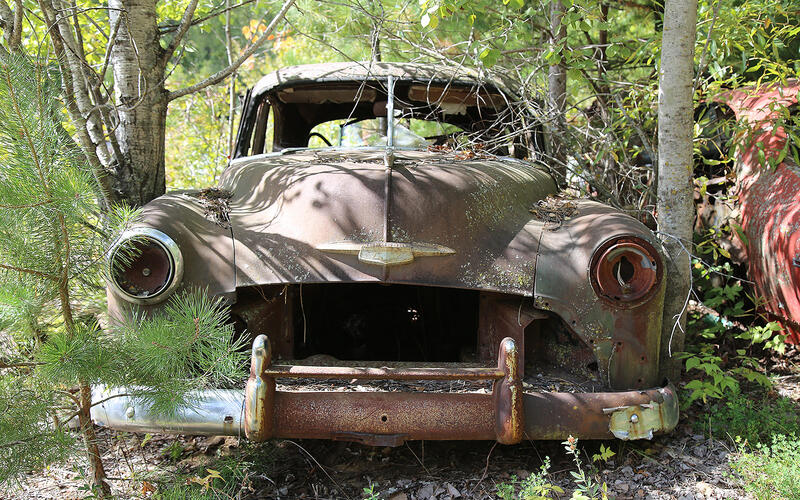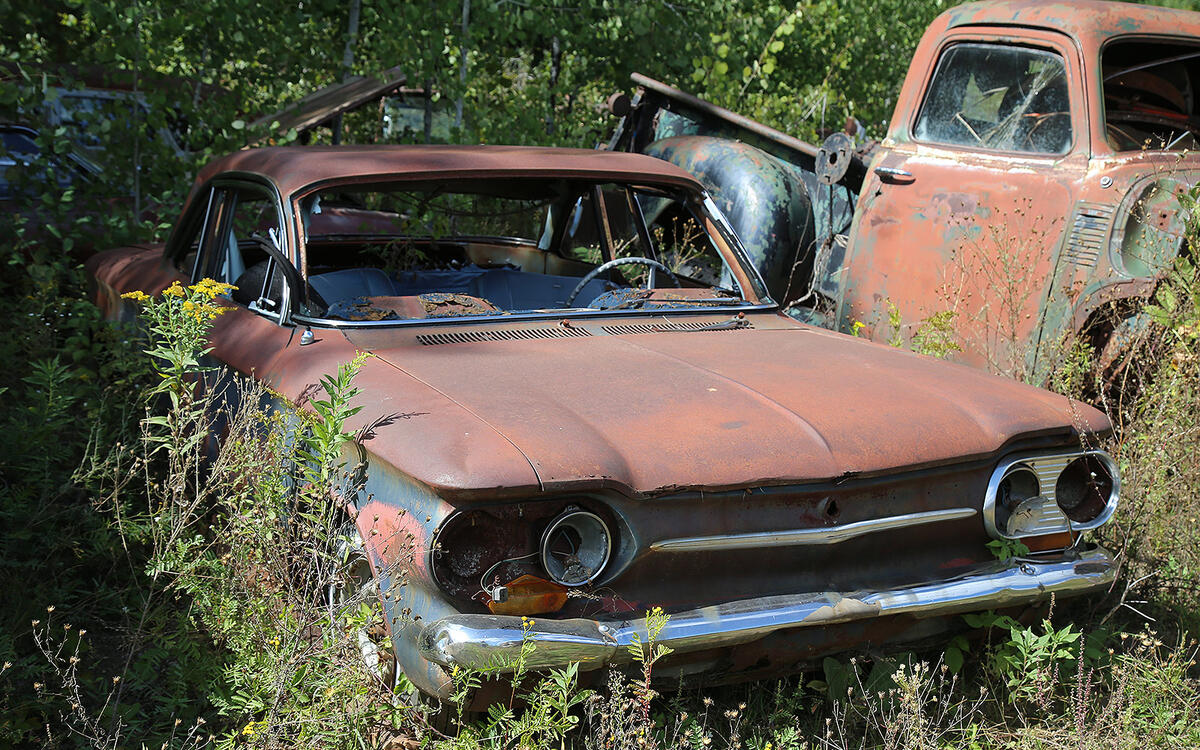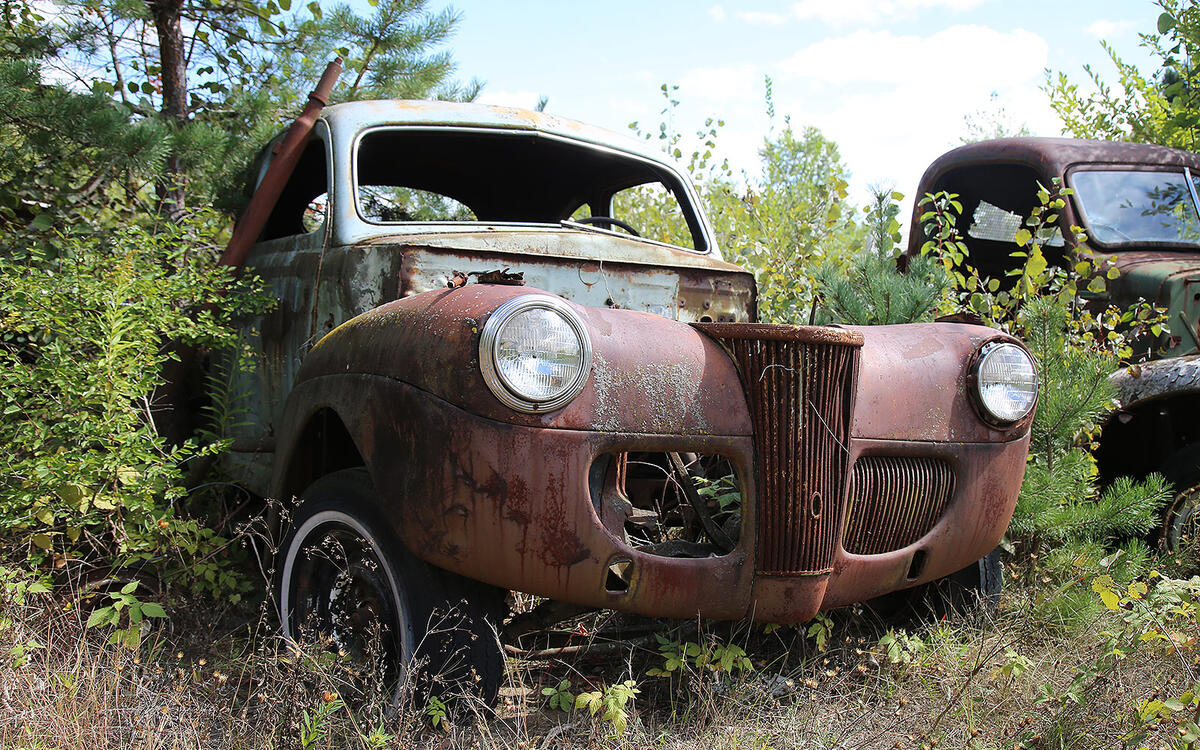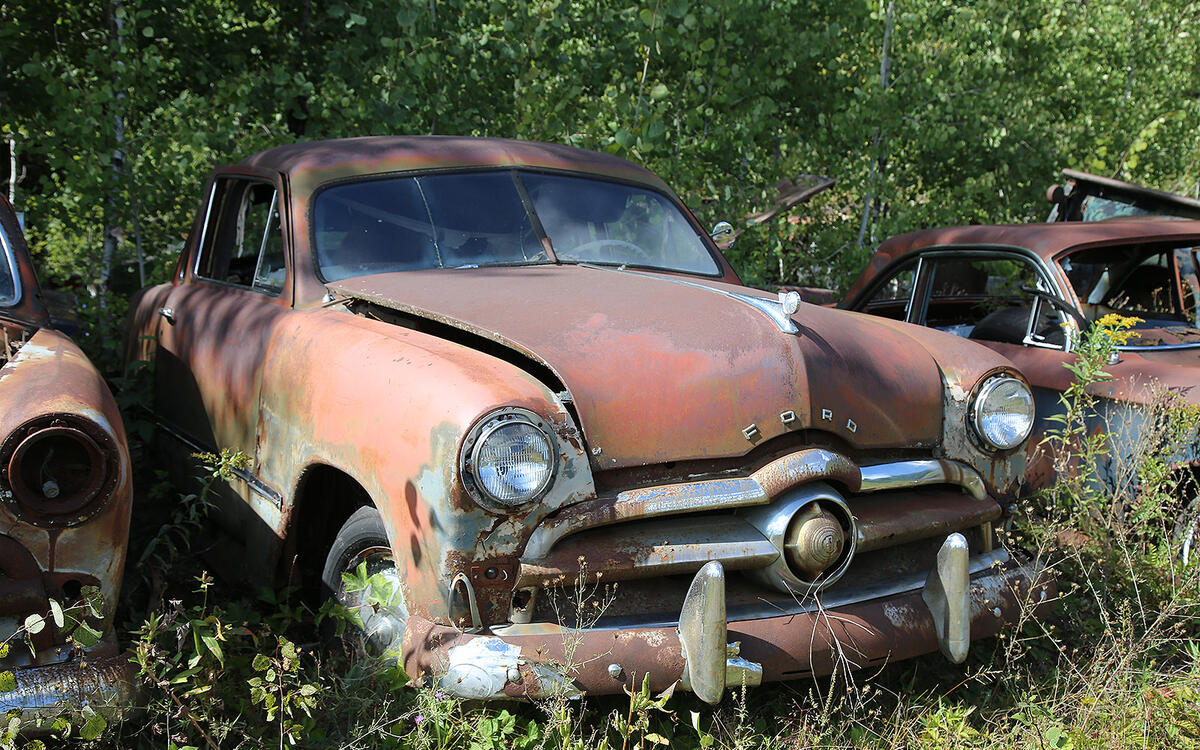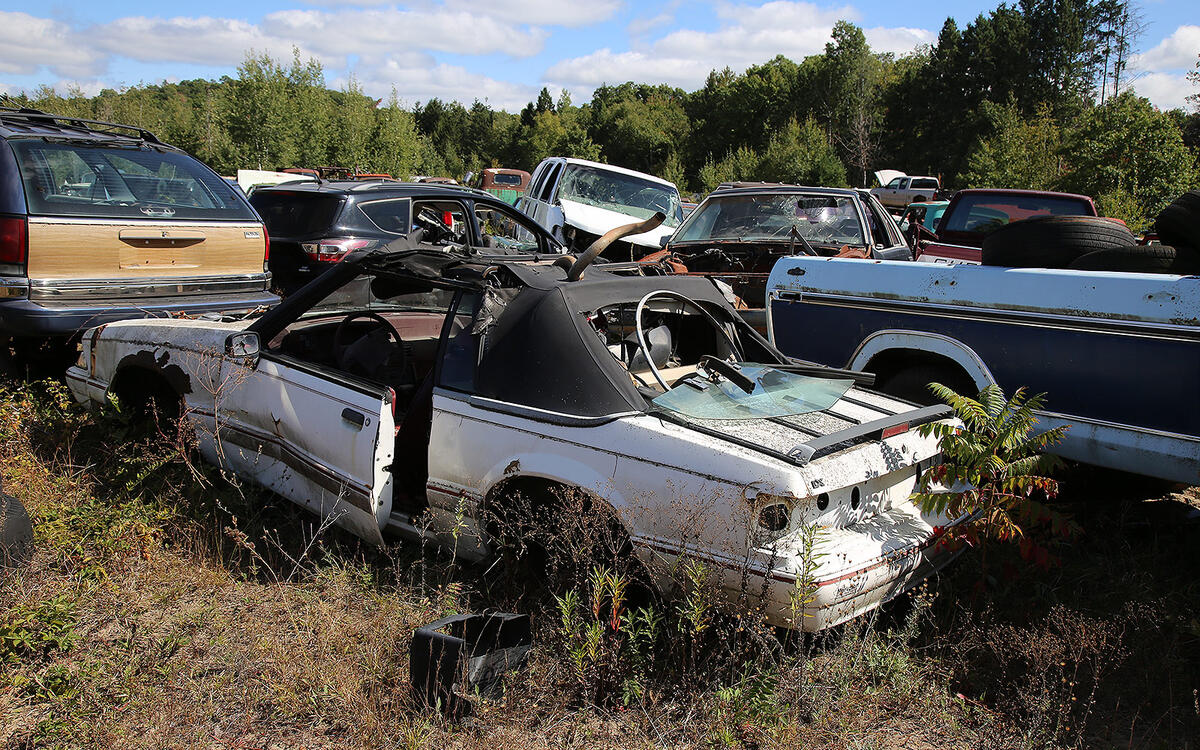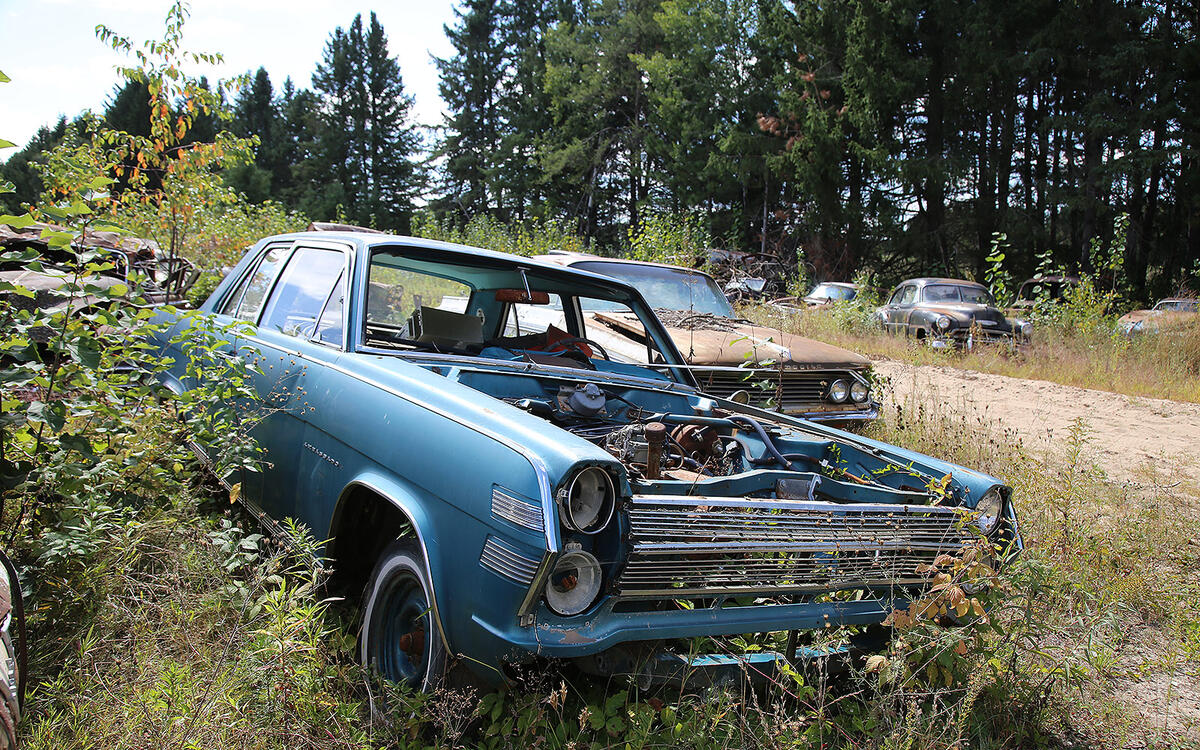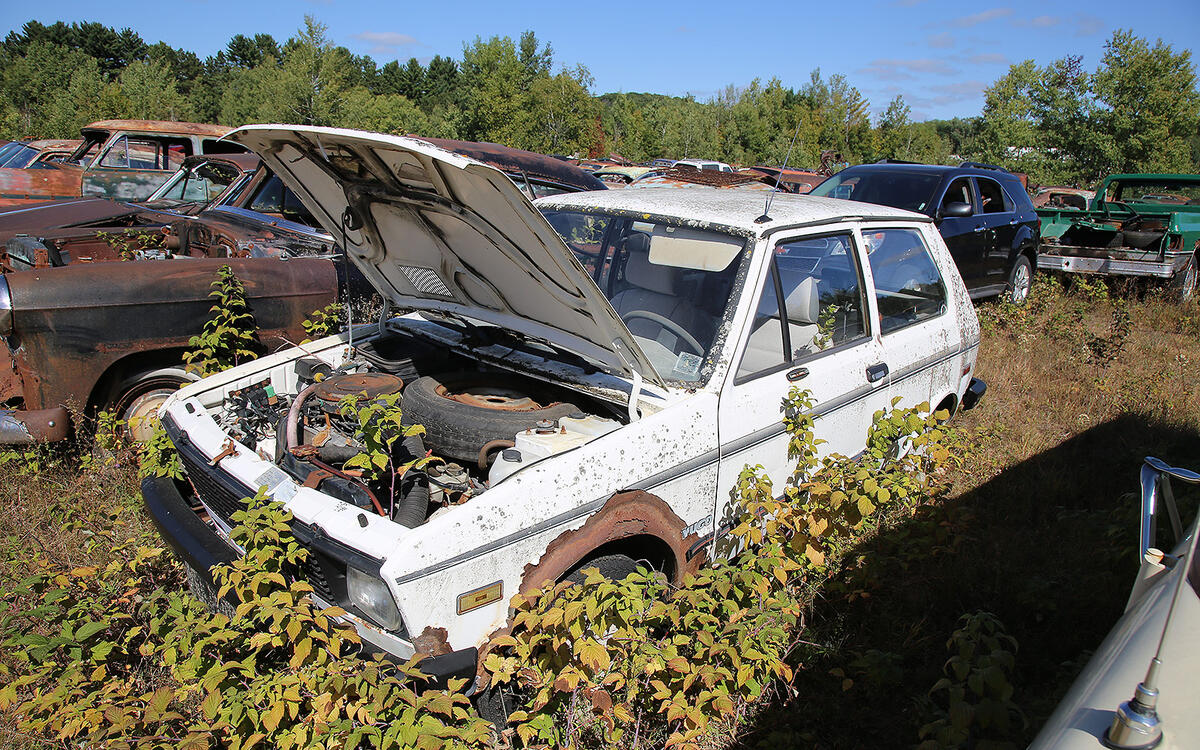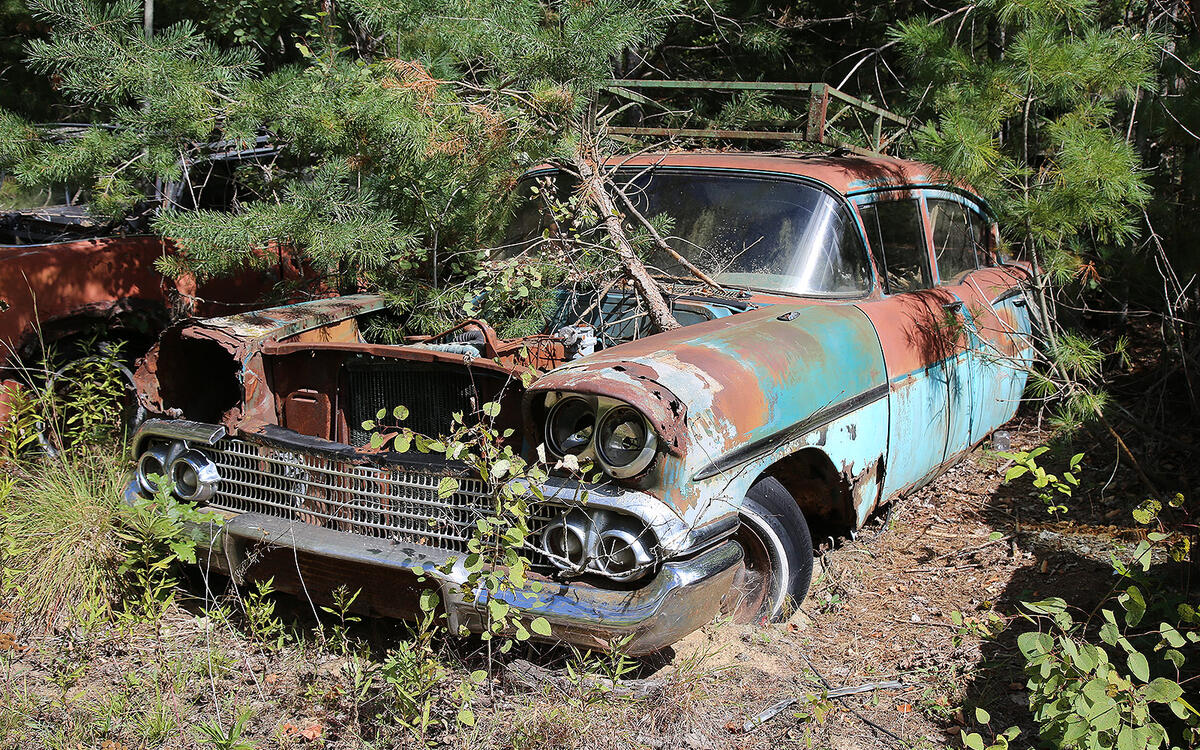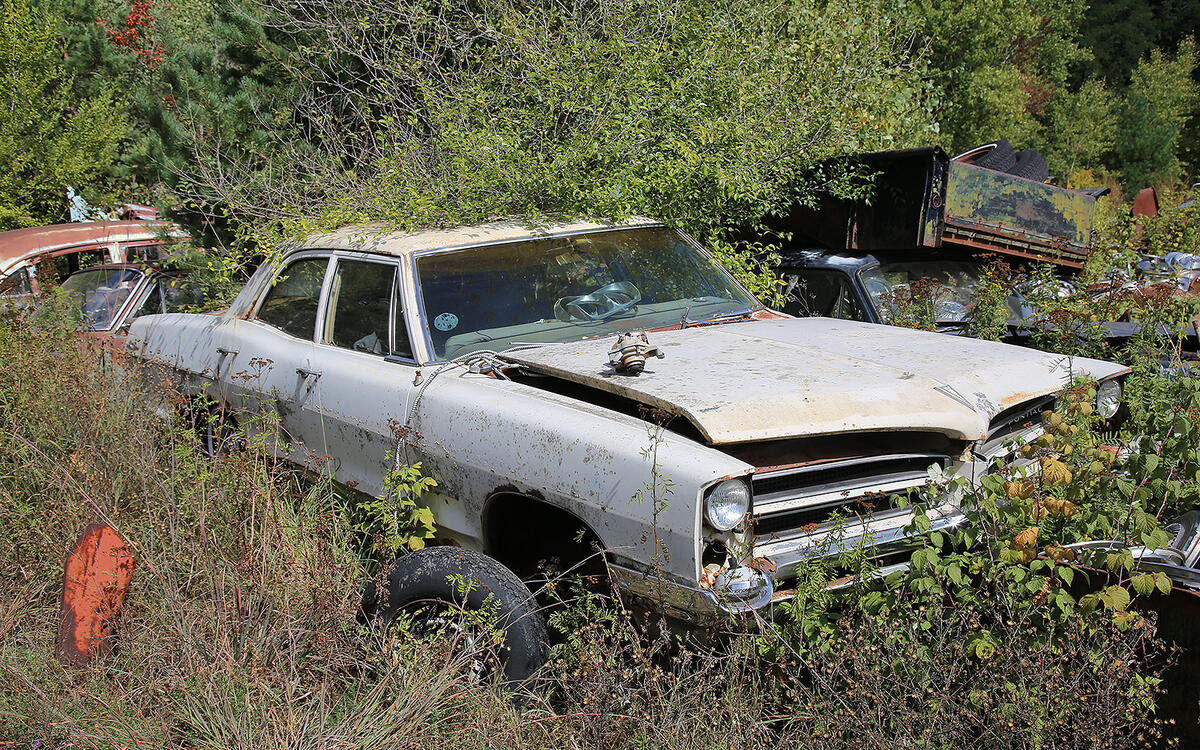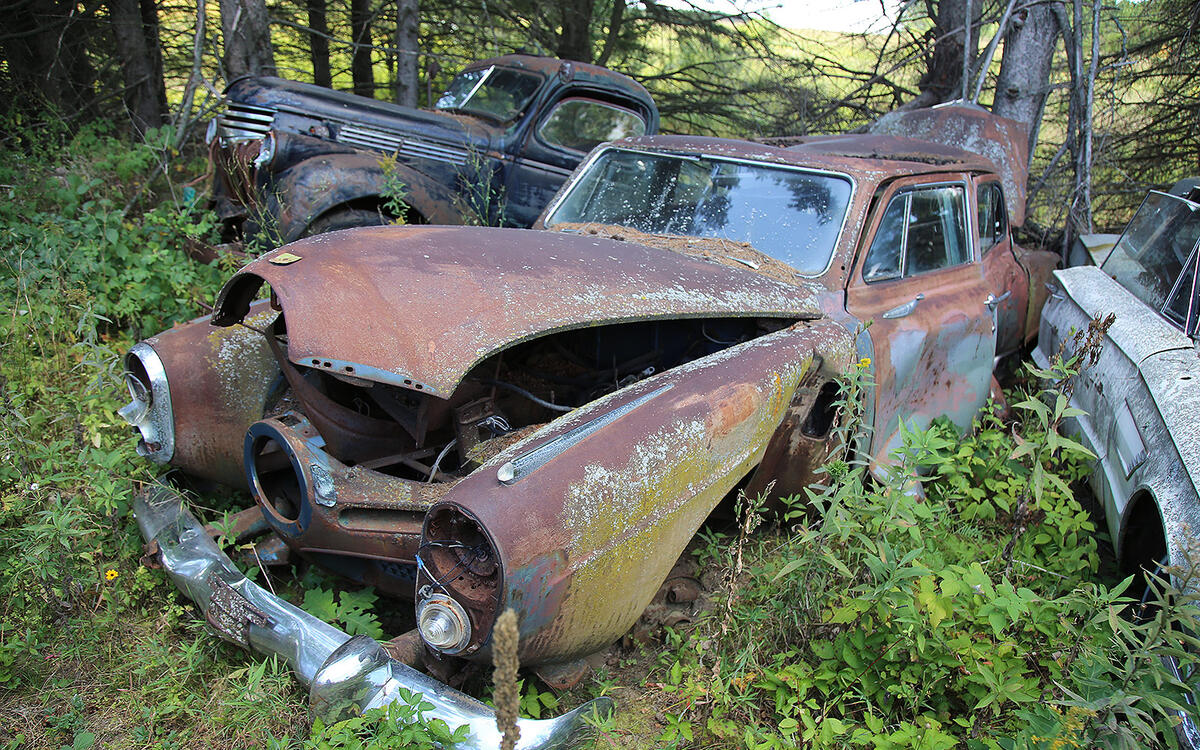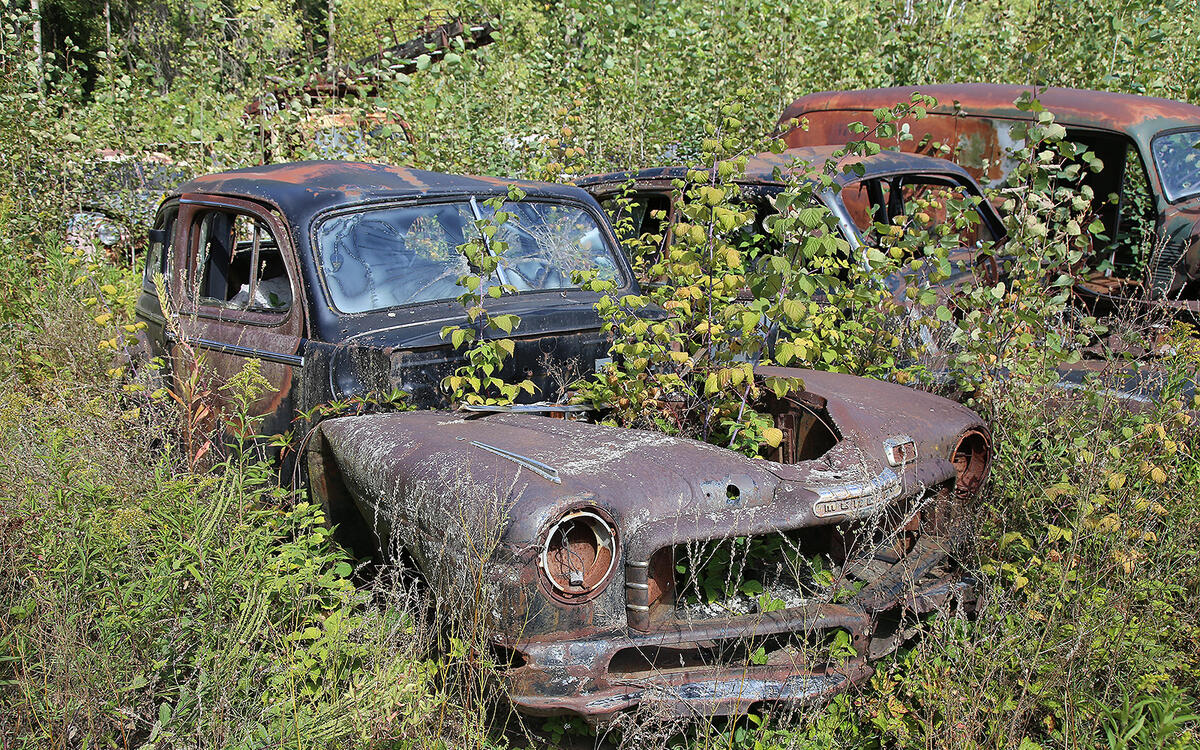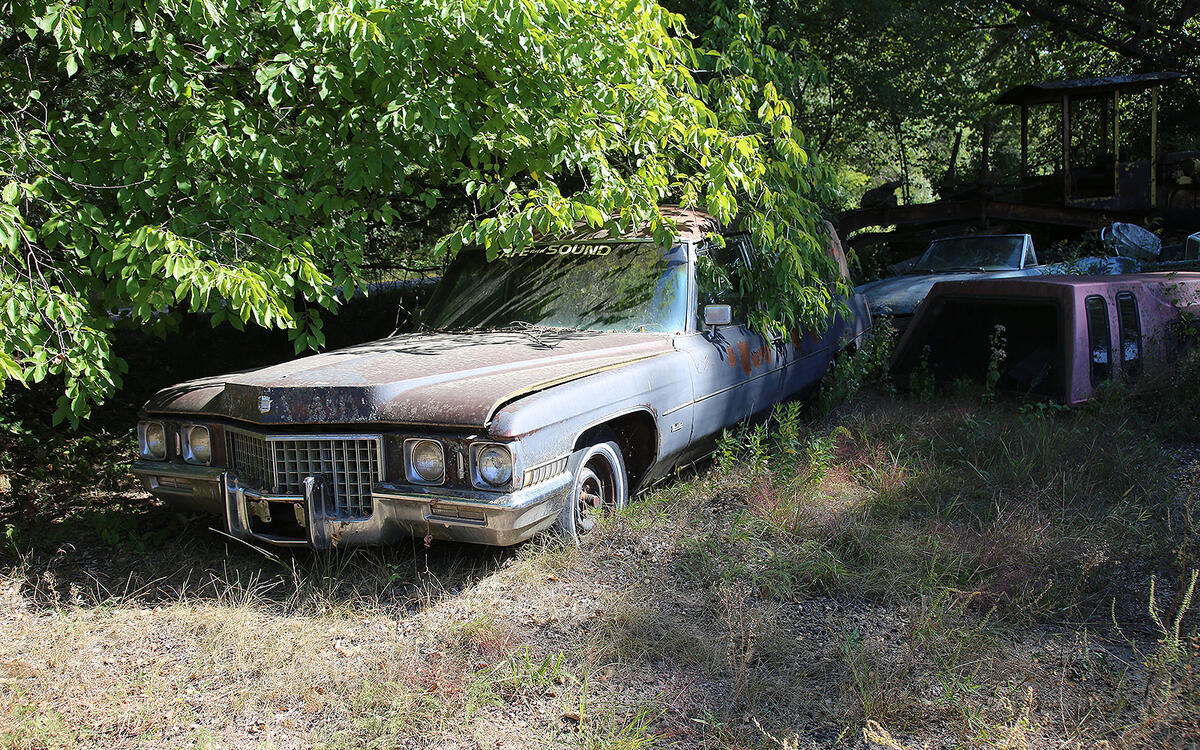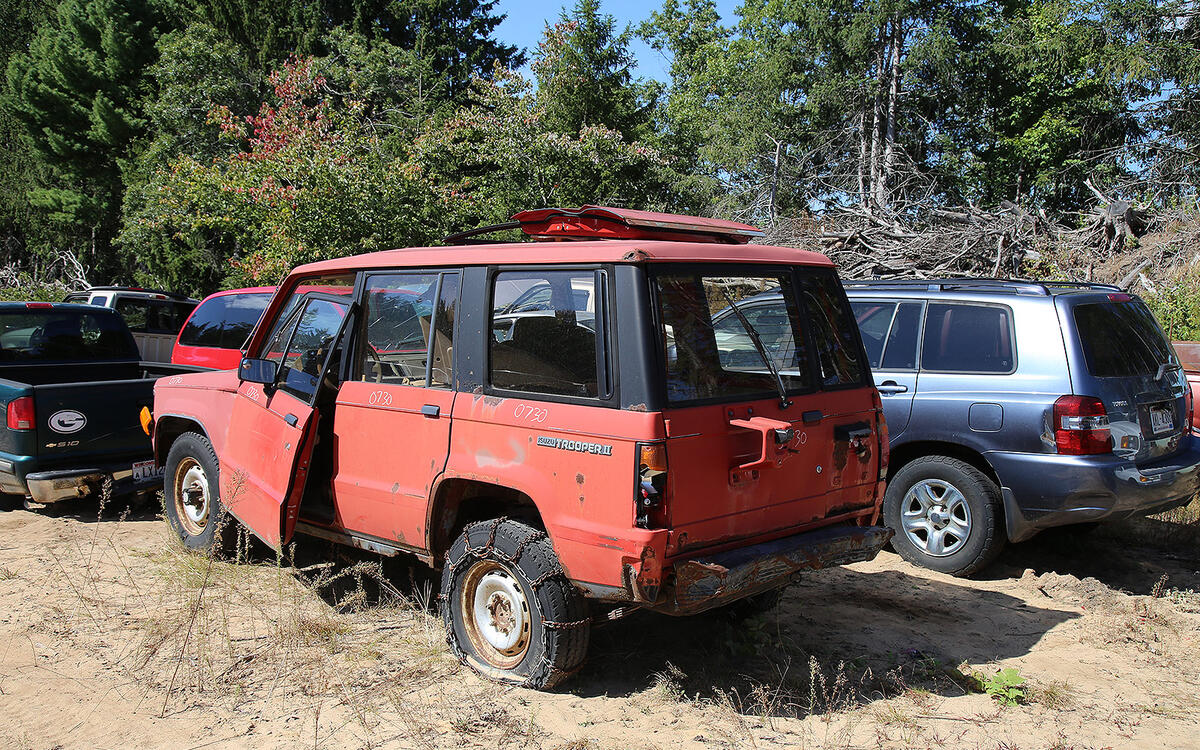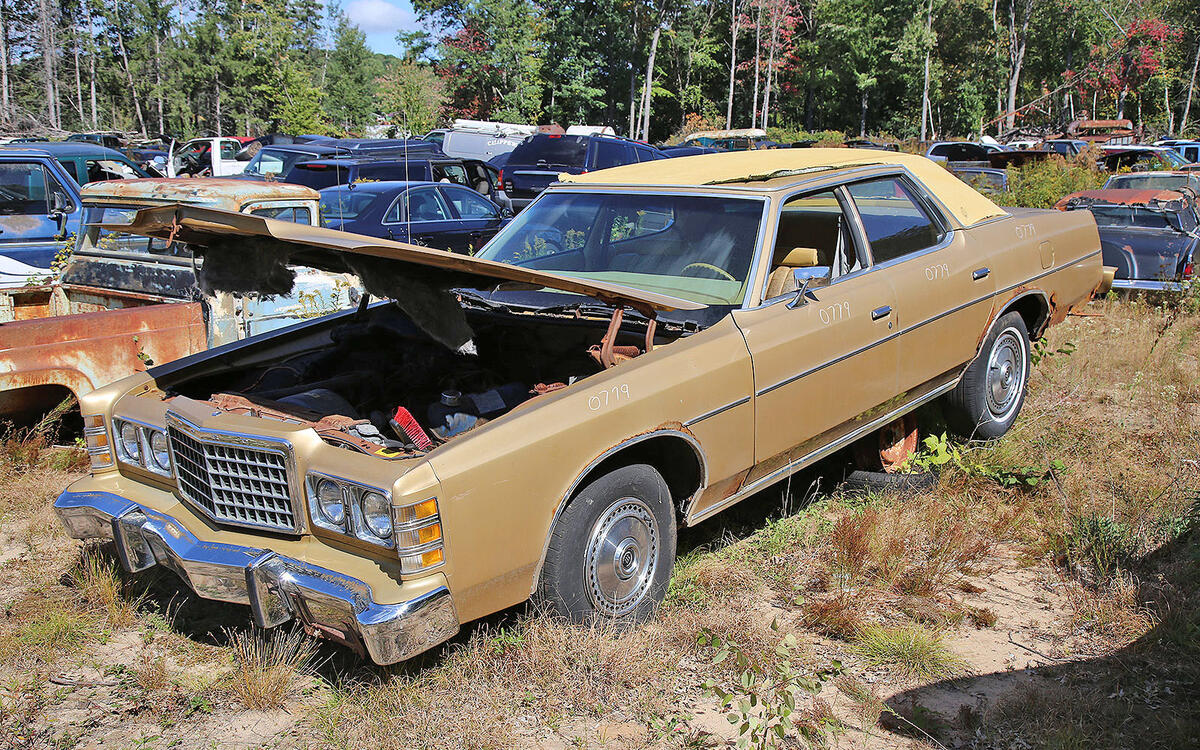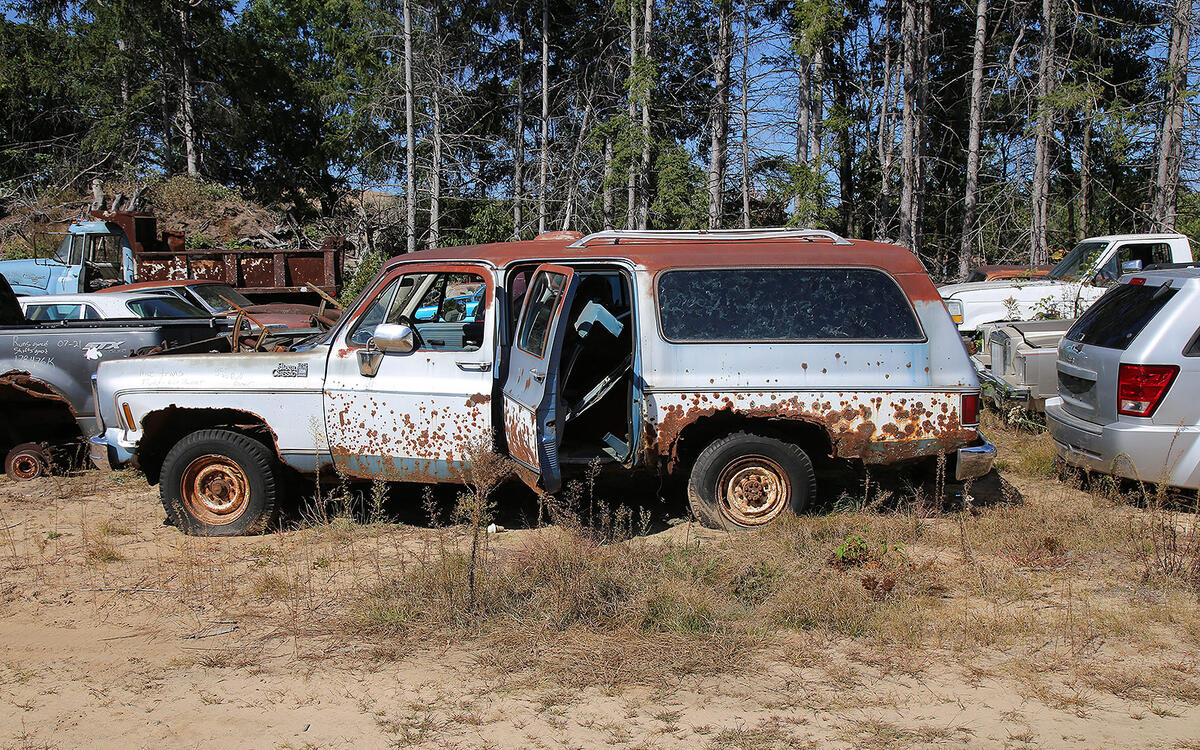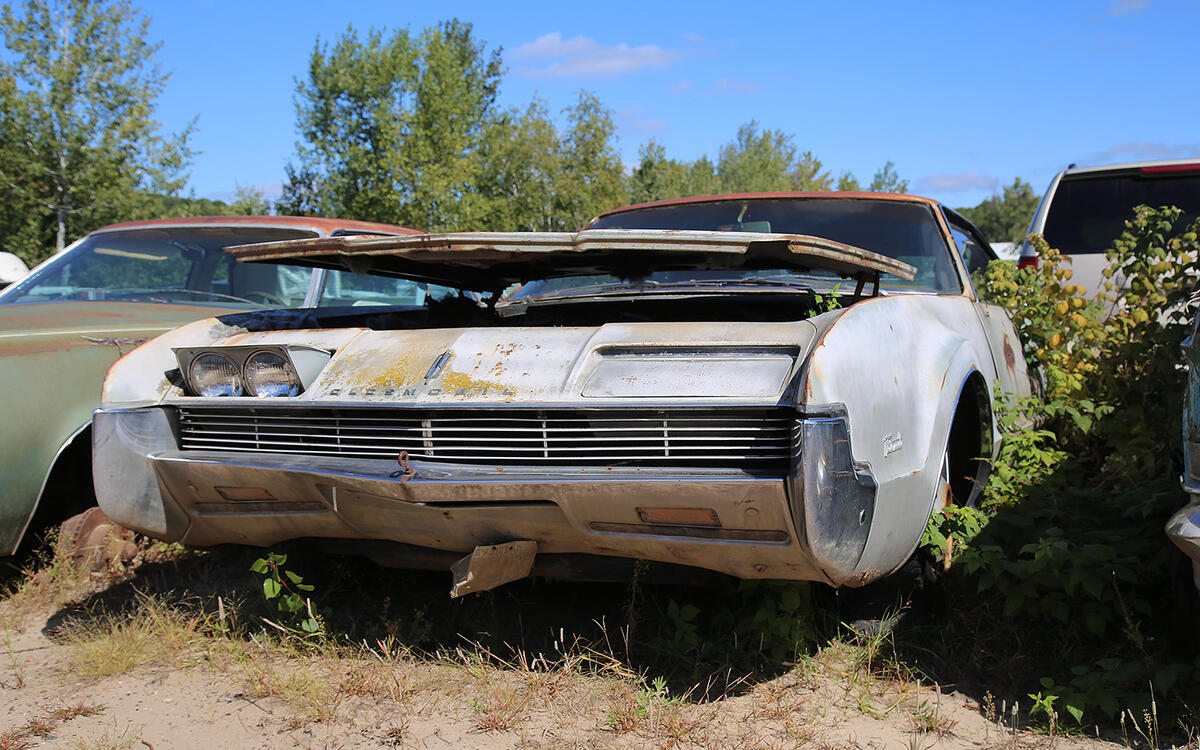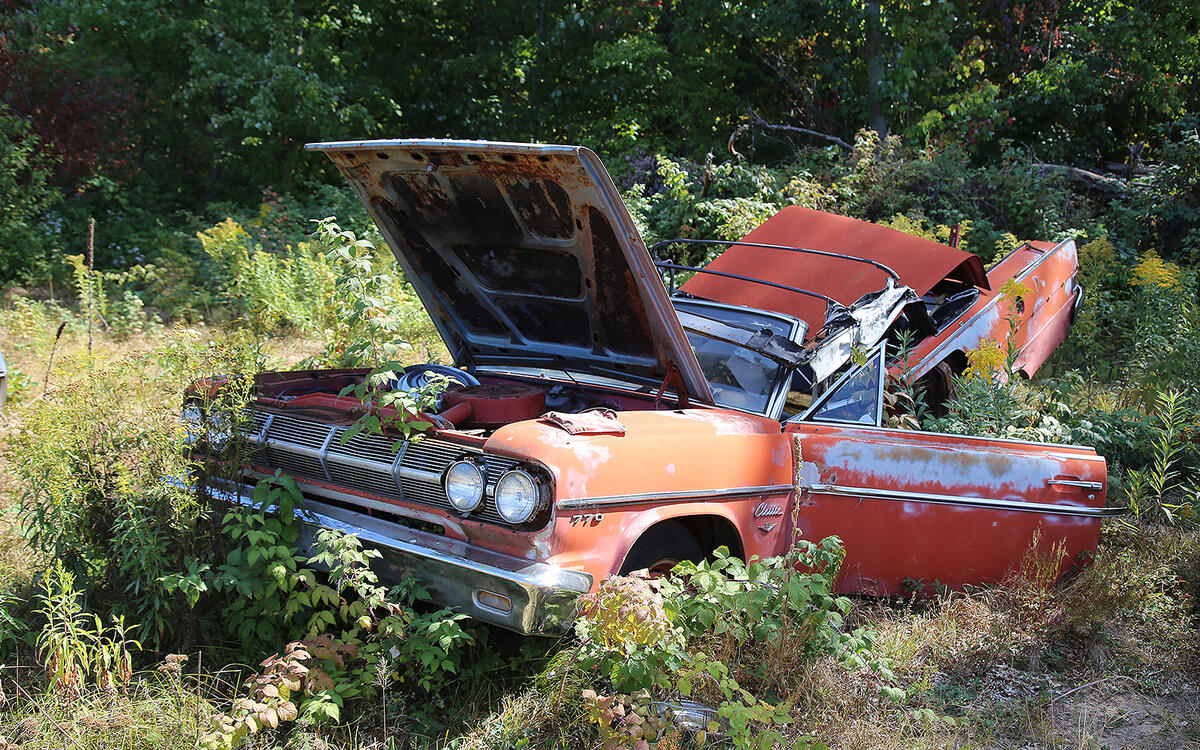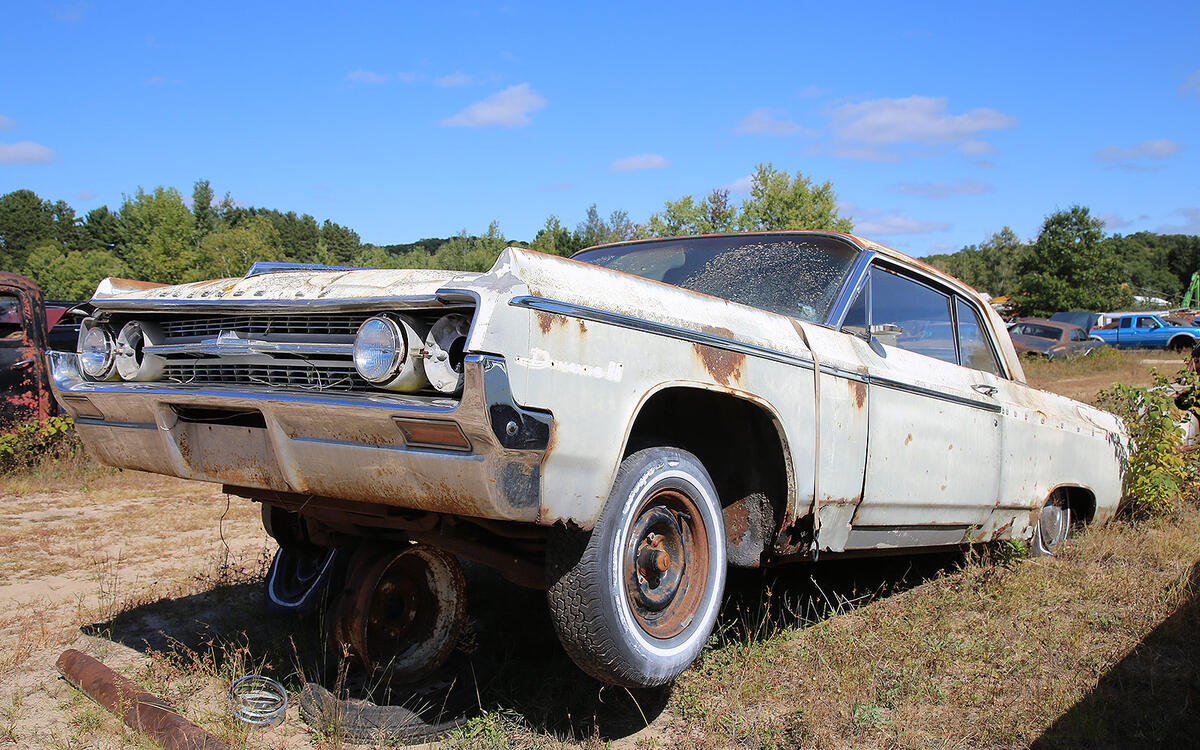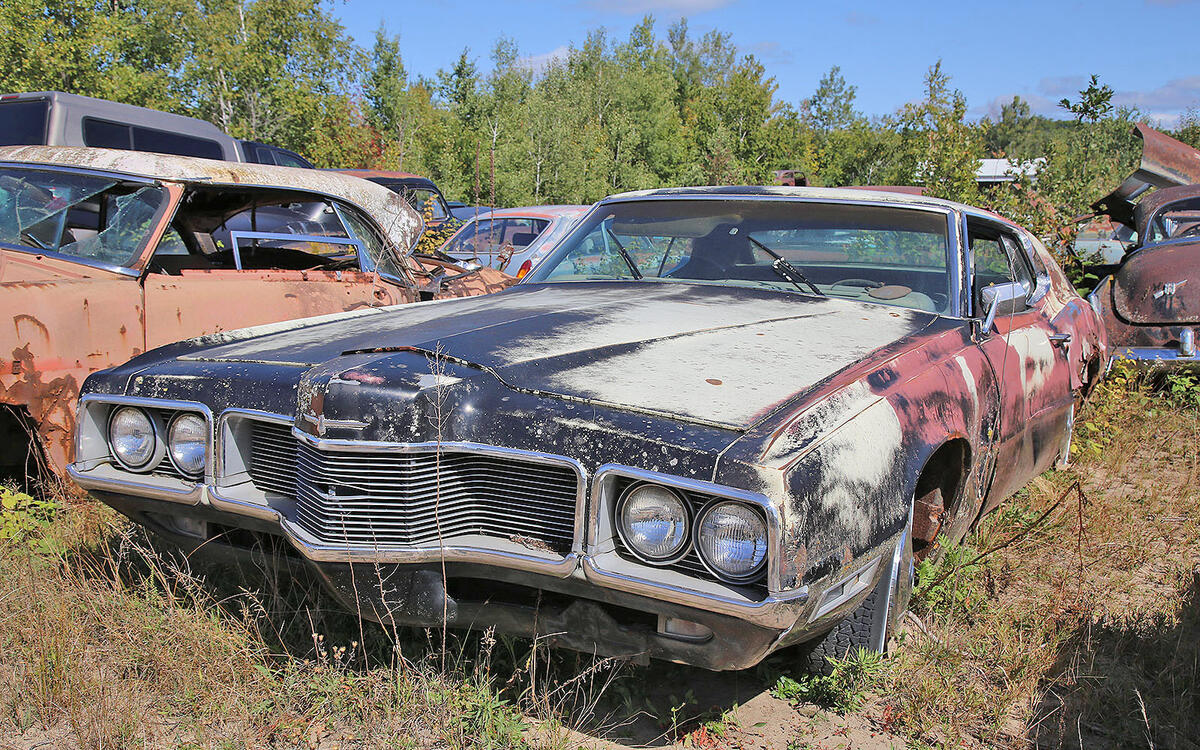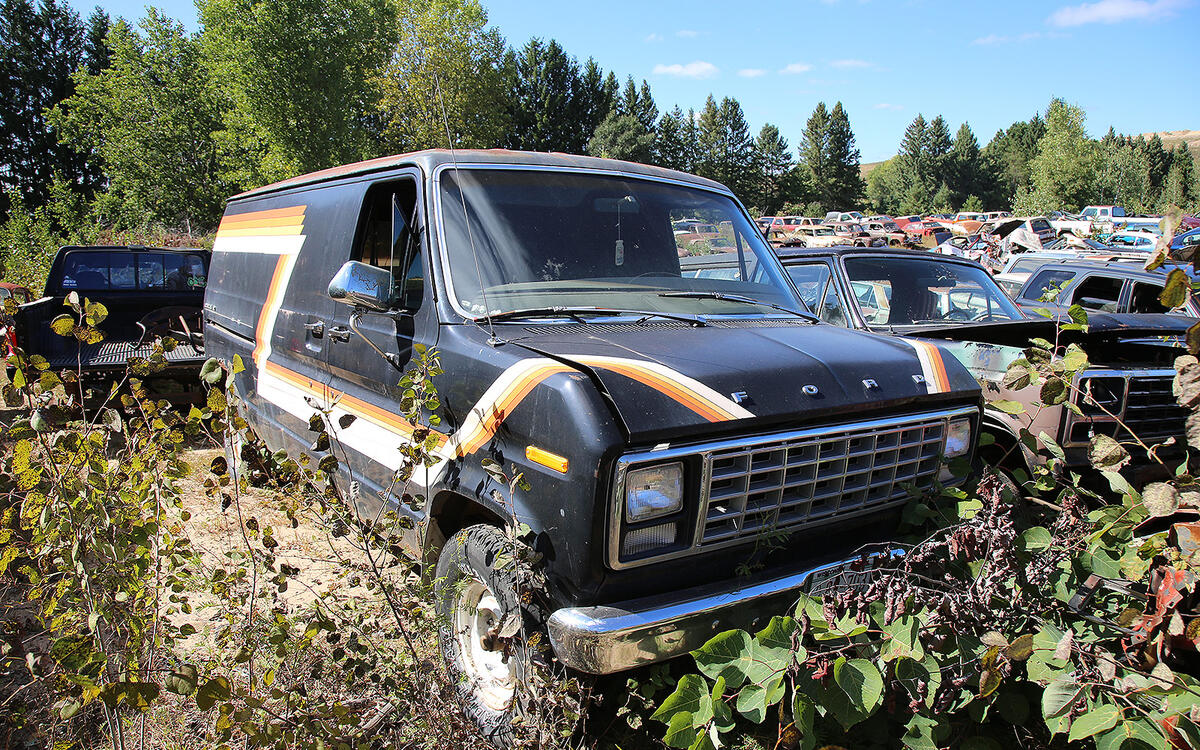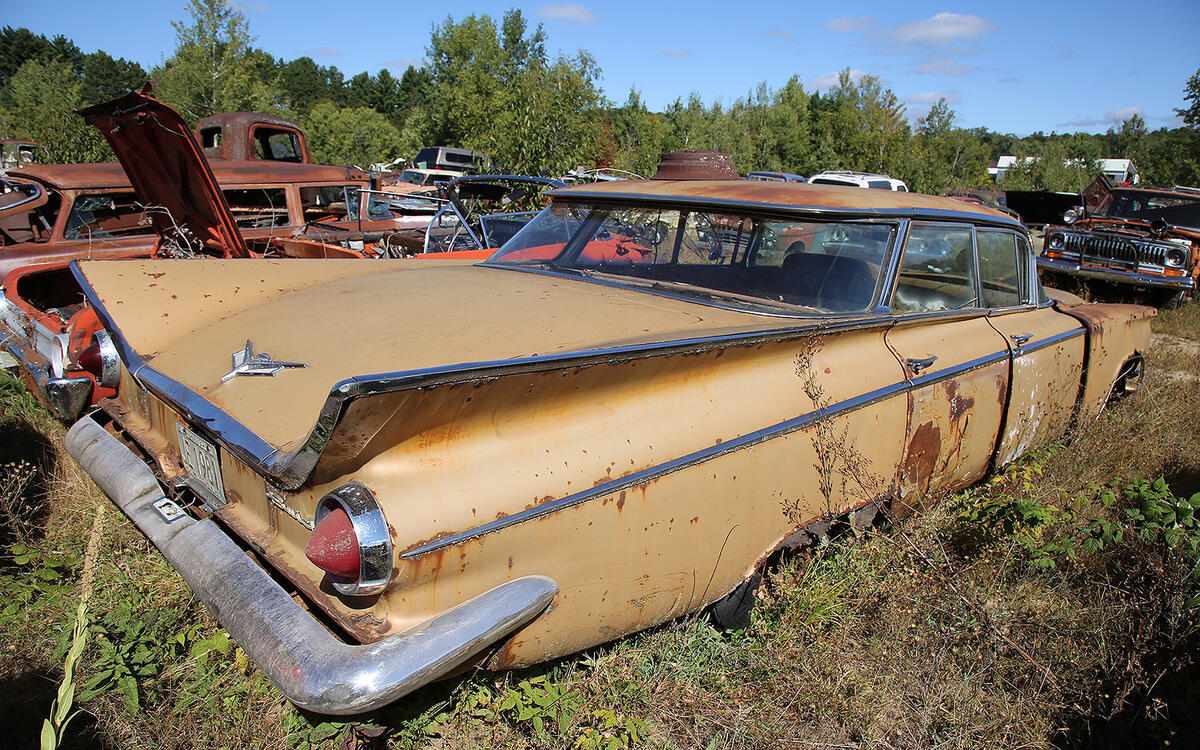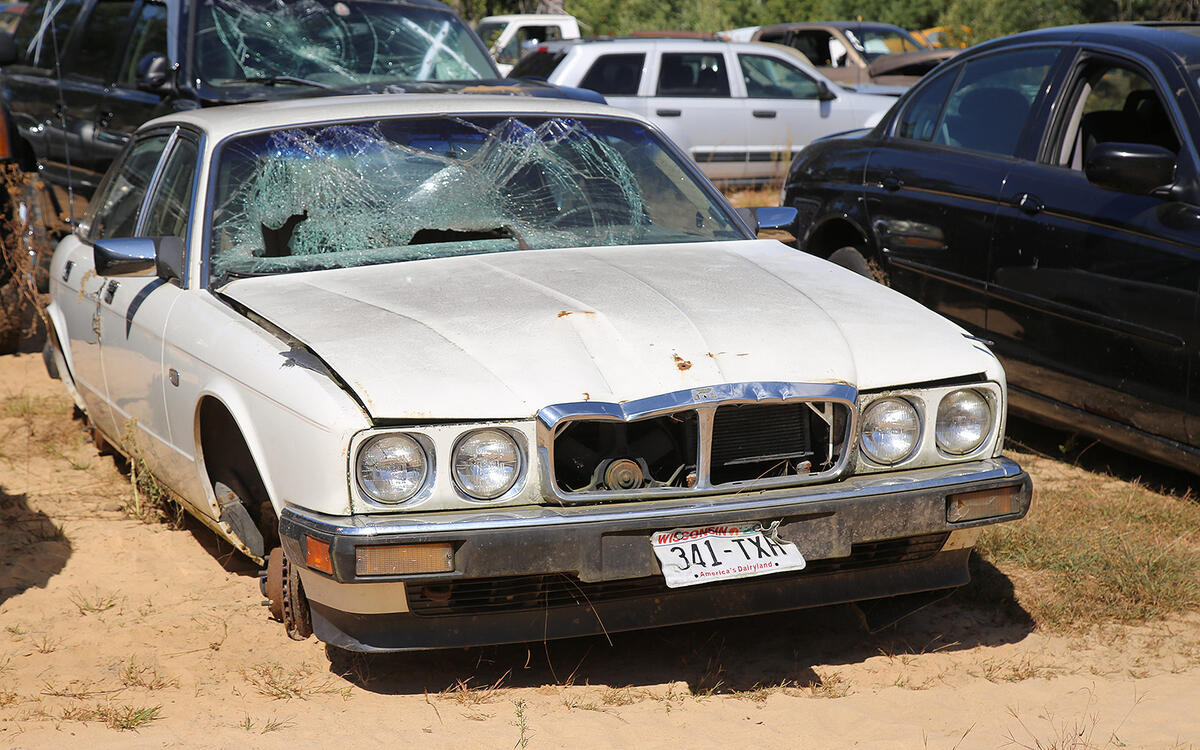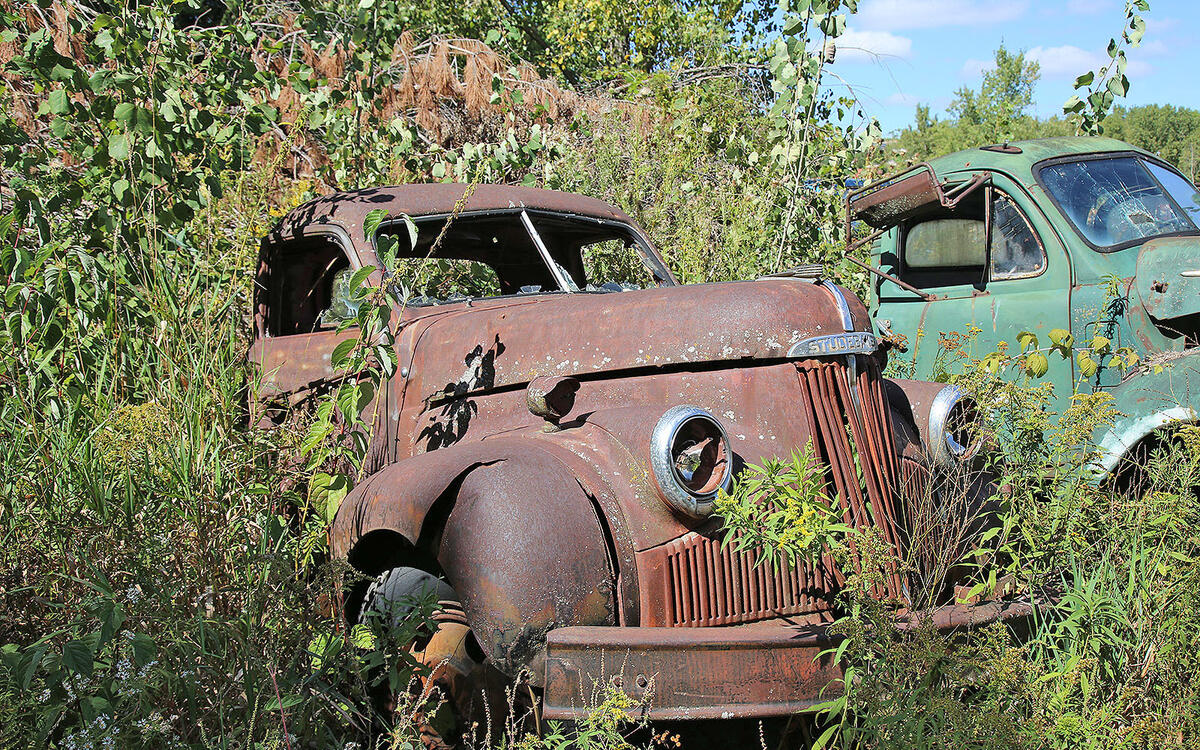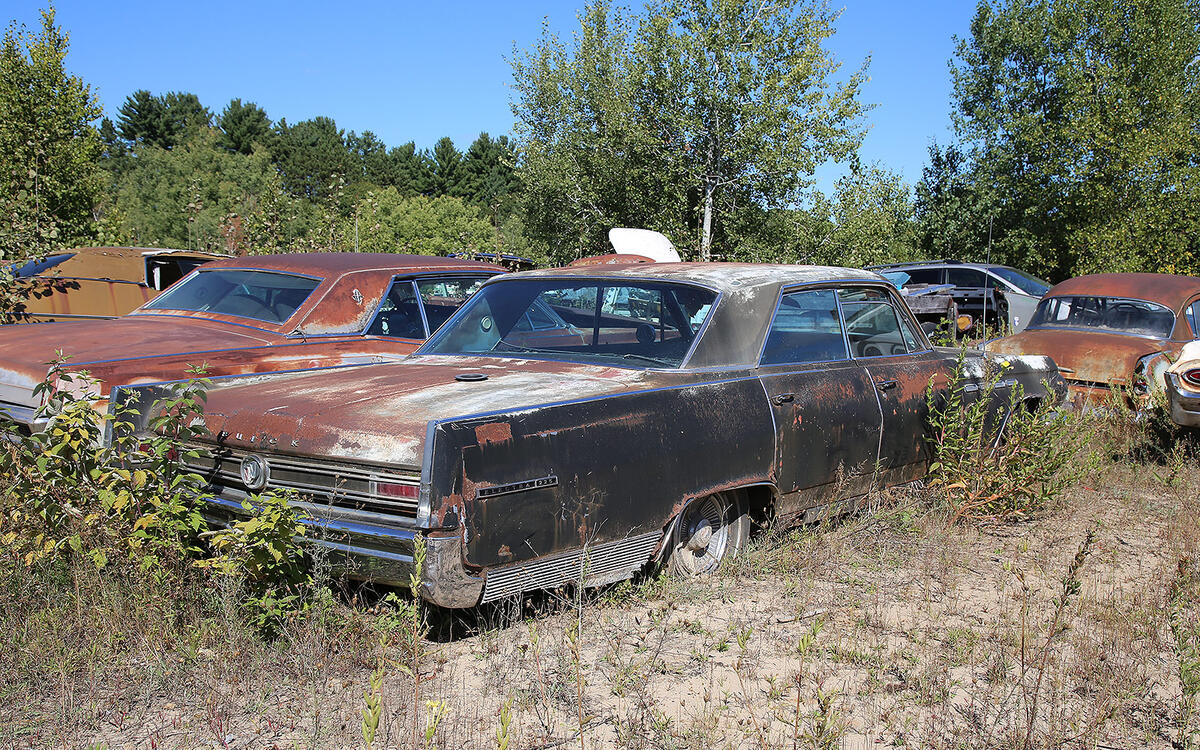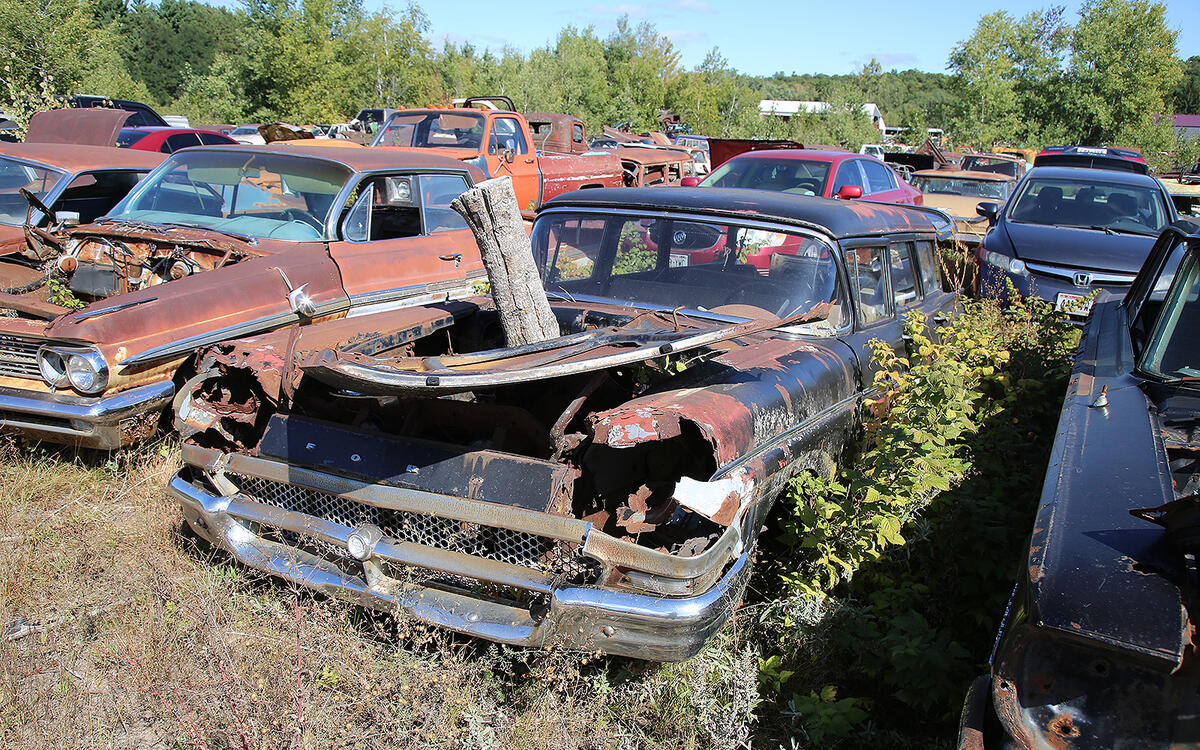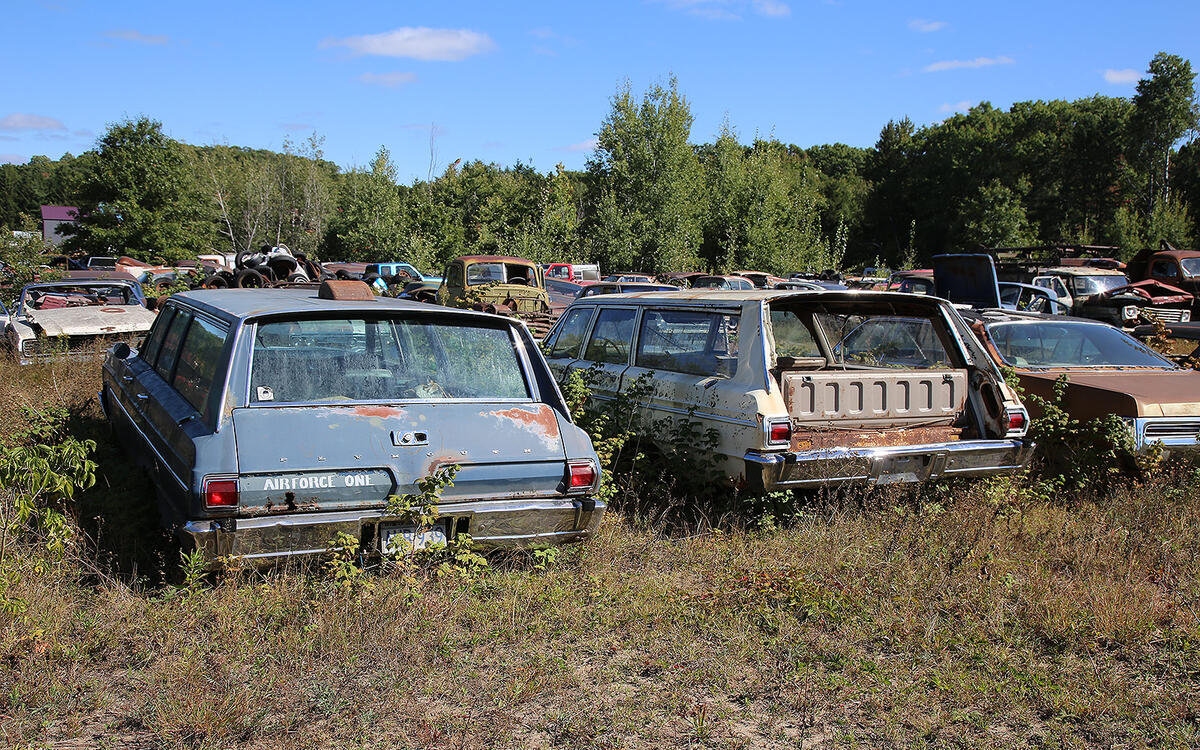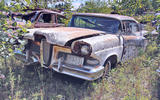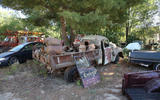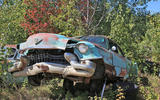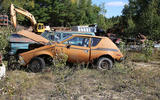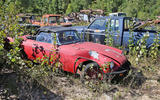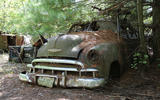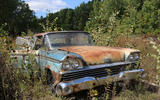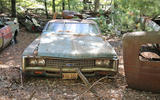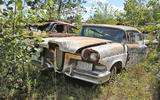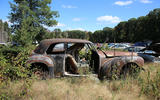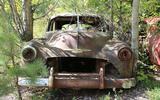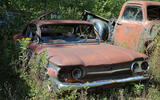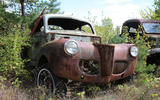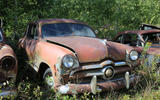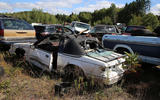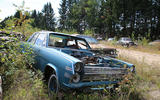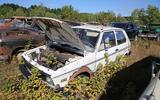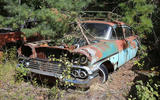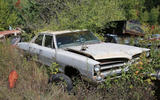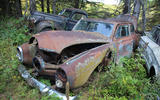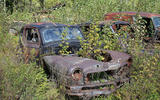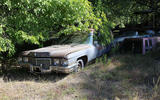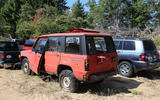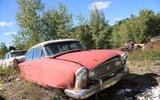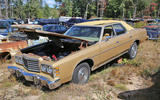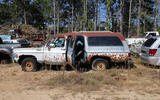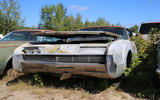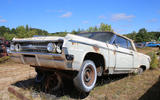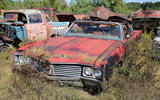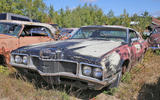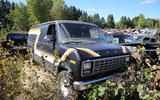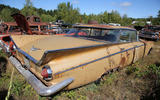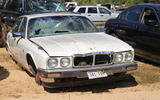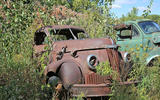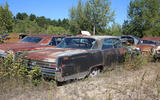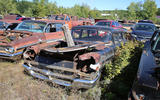 Slide of
Slide of
This business traces its origins back to 1964, and having spent an afternoon exploring the place, we reckon some of the stock has been here for most of those six decades.
But as you’ll see in this report, our second from this amazing yard, there’s plenty of newer and equally interesting vehicles too.
This is the tantalizing scene that greets visitors to Cooley’s Statewide Scrap and Salvage of Eau Claire, Wisconsin. But this is just a hint of some of the interesting cars to be found here.
 Slide of
Slide of
Welcome
This is the tantalizing scene that greets visitors to Cooley’s Statewide Scrap and Salvage of Eau Claire, Wisconsin. But this is just a hint of some of the interesting cars to be found here.
 Slide of
Slide of
CADILLAC - 1955
A record 118,190 Series 62 were sold in 1955, accounting for 84% of all Cadillacs built that year. Despite weighing-in at 4540 lb (2059kg), when pushed hard the 5.4-liter V8 could propel its occupants to 60mph in just over 12sec. It had a claimed top speed of 107mph.
 Slide of
Slide of
AMC GREMLIN
The AMC Gremlin’s rear-end styling was distinctive, to say the least, as it was basically a cut-down Javelin. This example, however, has an equally unusual front end. Corrosion has taken its toll, and it appears to have snapped. We wonder if this new ultra-aerodynamic profile might have improved its abysmal 20mpg.
 Slide of
Slide of
BUICK SPECIAL - 1955
This 1955 Buick Special has certainly seen better days. Nestled in a remote corner of the yard, it appears to have been a resident of Cooley’s Statewide Scrap and Salvage for decades, judging by how deeply it's sunk into the dirt. Nonetheless, it still boasts an abundance of relatively rust-free parts.
 Slide of
Slide of
MG MGB
The rubber bumpers on this MG MGB indicate that it is a post-1975 model. To comply with US bumper standards, parent company British Leyland decided to introduce the controversial styling worldwide. Additionally, the MG had to meet new US headlight height regulations. Instead of redesigning it, the manufacturer opted to raise the car by one inch, significantly compromising its handling in the process.
 Slide of
Slide of
CHEVROLET - 1949
Parking cars under trees is never a good idea, especially not under pine trees. Falling needles can get into crevices, and when damp, they wreak havoc on the sheet metal.
The toothy grille and round parking light orifices identify this car as a 1949 model, the first year of Chevrolet's all-new post-war design. Rival Ford, which launched its own all -new car in 1948, outsold Chevrolet by 108,000 units.
 Slide of
Slide of
FORD - 1959
While the front half of Cooley’s Statewide Scrap and Salvage is a hive of activity, with large machinery sorting and crushing scrap metal, the rear of this massive yard offers a stark contrast. The only sounds you hear are birdsong and the rustle of rabbits moving through the underbrush, creating a surprising oasis of peace and tranquillity.
Amid this serene setting, a 1959 Ford sits, retaining many of its parts, including an unusual grille.
 Slide of
Slide of
LINCOLN CONTINENTAL - 1959
The 1959 Lincoln Continental MkIV shared its body with the Premier but was distinguished primarily by its distinctive reverse-slant roofline. The late 1950s were challenging years for the Lincoln brand as it struggled to recoup the development costs of new vehicles during a recession. Despite its financial difficulties, Lincoln managed to fare better than sibling brand Edsel.
 Slide of
Slide of
CHEVROLET IMPALA - 1969
According to its license plate tags, this 1969 Chevrolet Impala Custom Coupe hasn’t been on the road since 1978. Presumably it hasn’t been in Cooley’s Statewide Scrap and Salvage for all that time, as it still retains most of its parts.
Total Chevrolet production in 1969 was 2,092,947, of which 777,000 were Impalas.
 Slide of
Slide of
EDSEL PACER - 1958
1958 was Edsel’s best year, with 68,045 cars sold. However, with 18 different body styles available, no individual model achieved significant sales volumes. The Pacer two-door hardtop was one of the better sellers, yet accounted for only 6,717 sales.
In 1959, the Pacer was dropped from the Edsel line-up, and overall production fell to 47,396 units.
 Slide of
Slide of
AUDI 100LS
Developed by Volkswagen subsidiary Auto Union, the original Audi 100, produced from 1968 to 1976, was a sales success. Named for the top horsepower rating of its 1.8-liter engine, the Audi 100 became the brand's largest and most successful model to date.
This LS four-door sedan appears to have been heavily vandalized prior to arriving at Cooley’s, explaining its lack of glass. However, somehow its taillights survived the attack.
 Slide of
Slide of
LINCOLN CONTINENTAL - 1941
Not much is left of this 1941 Lincoln Continental, yet its mere existence is remarkable. It's a rare find indeed to stumble upon one in a salvage yard. Powered by a 120hp 4.8-liter V12, now absent in this instance, this car boasted reasonable performance for its time.
Accelerating to 60mph in around 18sec, it could reach a top speed approaching triple figures. Among the 1251 Continentals sold that year, only 850 were two-door coupes like this one.
 Slide of
Slide of
CHEVROLET - 1951
The trees likely weren't present when this 1951 Chevrolet was originally parked in this spot. Over time, the one on the left has grown into the car, creating an ever-increasing dent in its side.
1951 was a challenging year for the US automobile industry, as the government restricted car production to prioritize metals for the Korean War effort. Nickel was removed from the chrome-making process, leading to premature rusting. This bumper certainly hasn’t aged well.
 Slide of
Slide of
CHEVROLET MONZA
In his book of the same title, Ralph Nader famously described the Chevrolet Corvair as being ‘Unsafe at Any Speed’, and without a windshield or headlights we would be inclined to agree with this assessment… However, in reality, the Corvair was no less safe than other cars from its era.
Judging by how the dashboard has rusted out, this 1963 Corvair Monza has been missing its glass for a number of years.
 Slide of
Slide of
FORD - 1941
Launched during the uncertain times of the second world war, the 1941 Ford introduced a new design. Although it reappeared for the 1942 model year, its production was short-lived as US car factories shifted their focus to manufacturing military trucks, tanks, airplanes, Jeeps, and weapons. The 1941 Ford returned in 1946 and continued in production until 1948.
 Slide of
Slide of
FORD - 1949
In 1948, Ford launched its new post-war model, the first entirely new car introduced after the death of founder Henry Ford. This vehicle – launched for the 1949 model year - was redesigned from the ground up, retaining only the wheelbase and drivetrain from the previous generation. Known as ‘Shoebox Fords’ for their slab-sided styling, these cars were well received by the public, propelling Ford back to the top sales spot.
 Slide of
Slide of
FORD MUSTANG CONVERTIBLE
Look at the chronic corrosion on the front fender of this early 1990s Ford Mustang LX convertible. The same story likely applies to the car’s floorpan, which is probably why it ended up in the salvage yard in the first place.
The third-generation Mustang, produced from 1979 to 1993, enjoyed a remarkable 16-year run and amassed a staggering 2.6 million sales.
 Slide of
Slide of
AMC AMBASSADOR - 1966
Check out the excellent condition of this 1966 Ambassador's distinctive front fender, which is completely rot-free. The rest of the car follows suit, with numerous parts in great shape.
This year marked a significant change for the Ambassador as it shed its Rambler identity to be known as the AMC Ambassador. This rebranding was part of a deliberate strategy to move the model upmarket, and it appeared to work. In 1966, sales reached 71,000 units, an increase of 7,000 from the previous year.
 Slide of
Slide of
ZASTAVA YUGO
You have to admire the yard’s optimism in thinking that this Zastava Yugo GVL will ever earn its keep. Despite having been here for years, it appears yet to yield a single spare part. Simply put, there’s not a lot of love for these cut-price European rot-boxes.
Built in the former Yugoslavia, these affordable cars were imported into the US between 1985 and 1992, with 141,651 frugal motorists placing orders.
 Slide of
Slide of
CHEVROLET BEL AIR - 1958
Having sat in the same spot for decades, this 1958 Chevrolet Bel Air has sunk so deeply that its floor now rests in the Wisconsin soil. As a result, the sills resemble Swiss cheese.
The four-door sedan, which attracted more than 491,000 buyers, was Chevrolet’s best-selling model that year, helping the brand reclaim the top sales spot from rival Ford.
 Slide of
Slide of
PONTIAC CATALINA - 1966
At the time of our visit to Cooley’s Statewide Scrap and Salvage, some parts of the yard were being engulfed by the undergrowth. While this 1966 Pontiac Catalina remains visible, the surrounding cars have almost completely disappeared beneath the vegetation. This makes us wonder about the hidden gems we might have missed.
 Slide of
Slide of
STUDEBAKER CHAMPION - 1950
This is one of the 46,027 Champion Deluxe four-door sedans built in 1950, comprising about 15% of Studebaker's total production that year. 1950 was a record year for the marque, with sales reaching 321,000 units. Unfortunately, within a few years, Studebaker struggled to achieve six-figure sales again.
 Slide of
Slide of
MERCURY - 1946
Founded in 1938 by Edsel Ford, Mercury was still relatively new to building cars when this one rolled off the line. It’s a 1946 four-door sedan, which went into production in November 1945, following a hiatus during World War II. Some 87,000 examples were sold, making Mercury the tenth most popular car brand in the US.
 Slide of
Slide of
PACKARD - 1952
Confusingly, the 1963 Chevrolet hood is a perfect color match for the far older car it’s perched on. We believe it to be a 1952 Packard 200 four-door sedan, but from this angle there’s not a whole lot to go by. These were poverty-spec entry level cars, with the least powerful V8 engine.
 Slide of
Slide of
CADILLAC HEARSE - 1971
This 1971 Cadillac hearse is located by the yard’s entrance, so may well be a potential project car. It’s certainly complete, and in pretty good condition too. Cadillac supplied 2014 commercial chassis to the coachbuilding trade that year, making this an extremely rare vehicle.
It was built by Ohio-based professional car manufacturer Miller-Meteor, which is probably best known for building the Cadillac ambulance used in the 1984 movie Ghostbusters.
 Slide of
Slide of
ISUZU TROOPER 2
It was evidently snowing when this Isuzu Trooper made its final journey, as it still wears chains on its rear wheels. These practical, rugged off-roaders, sold in the US from 1984, provided a decent and more affordable alternative to the Toyota Land Cruiser. Although this vehicle is beyond saving, it still offers plenty of usable parts.
 Slide of
Slide of
NASH AMBASSADOR - 1956
With their covered wheel arches, Nash cars from this era already sat low to the ground, but never quite this low. This 1956 Ambassador Super has sunk into the soil, clearly having sat in the same spot for a long time. By 1956, the body style was in its fifth year, which was reflected in dwindling sales. The Nash Ambassador would soldier on for one more year before disappearing for good, though the name would continue to be used by the AMC and Rambler brands.
 Slide of
Slide of
FORD LTD - 1977
With its presentable paintwork and gleaming chrome, at first glance this 1977 Ford LTD looks solid, but then you notice the rotten rear fender. We crawled beneath the back of the car and can confirm that the horror story continues under there. More than 160,255 of these four-door pillared hardtops were built, but just a tiny fraction survives.
 Slide of
Slide of
GMC SUBURBAN
Someone has scribbled "Nice trans, fluid not burnt" on the front fender of this seventh-generation GMC Suburban Sierra Classic 25. A good gearbox seems to be one of the few positives about this truck, as the body panels are beyond rescue. The Suburban has been in production since the mid-1930s, making it the longest-running car name in history.
 Slide of
Slide of
OLDSMOBILE TORONADO - 1966
A first-generation Oldsmobile Toronado appears to be waking from its slumber, peering through one slightly open eye. This is one of 41,000 examples built in 1966, the coupe’s inaugural year. The Toronado's front-wheel-drive layout was revolutionary for its time, and remarkably, for a US-built car, it secured third place in the 1966 European Car of the Year competition.
 Slide of
Slide of
AMC RAMBLER CLASSIC 770 - 1965
With fewer than 5000 finding buyers, this 1965 AMC Rambler Classic 770 convertible is a rare car indeed. However, having snapped into two, it’s safe to say that its condition is terminal.
With a 145hp 3.8-liter six-cylinder engine under the hood, the car would manage 60mph in a rather leisurely 12.2sec.
 Slide of
Slide of
OLDSMOBILE DYNAMIC 88 - 1964
This 1964 Oldsmobile Dynamic 88 looks like it’s about to launch itself into orbit.
Just how far it will fly is very much dependant on what version of the 6.4-liter Rocket is under the hood. The 330 hp variant could manage 60mph in just 8.7sec, and a top speed of 127mph, so would be airborne for quite some time. It’s a two-door Holiday hardtop, one of 32,369 built that year.
 Slide of
Slide of
BUICK LE SABRE CONVERTIBLE - 1967
With fewer than 3000 examples rolling off the line, this 1967 Buick LeSabre convertible is an extremely rare car. However, as is so often the case, rarity and value don’t always go together. But it’s not as unusual as that hideous creation parked next to it, which incredibly we failed to notice during our visit.
 Slide of
Slide of
FORD THUNDERBIRD - 1970
The fifth-generation Ford Thunderbird, produced from 1967 to 1971, experienced strong initial sales that gradually declined over time. To revive interest in the model, Ford's designers gave it a significant facelift in 1970. This redesign featured a new angular hood and a distinctive protruding grille, intended to resemble a bird's beak.
While this example is largely intact, it is completely rotten, making it clear that its days of soaring down the road are long past.
 Slide of
Slide of
FORD ECONOLINE
We admire the period livery on this early 1980s Ford E150 Econoline van. However, we're less enthusiastic about the extensive rust on its lower half. Despite this, it still has air in all four tires, suggesting that it hasn't been off the road for long.
The E-Series has enjoyed a long and successful history, with 8.2 million units sold since its 1961 debut. This particular van is a third-generation model, produced from 1975 to 1991.
 Slide of
Slide of
BUICK LE SABRE - 1959
Despite being torn and frayed around the edges; this 1959 Buick LeSabre four-door hardtop remains remarkably complete. It originally came with a 250hp, 6.0-liter V8 engine, a powerplant that had been standard in all 1957 and 1958 Buicks. This engine enabled the car to cover the quarter mile in 17.6sec and reach a top speed of 112mph.
 Slide of
Slide of
JAGUAR XJ40
Although it was launched in 1986, Jaguar’s first all-new sedan since the late 1960s is far older than that. Original sketches and scale models date back to the early 1970s, and the project was finally approved in 1981. Although it lacked the distinctive curves of the Series III it replaced, the cars were well received and sold well.
While they had a reputation for rusting back in Britain, this one appears to be relatively corrosion-free.
 Slide of
Slide of
STUDEBAKER -M SERIES
Emerging from the undergrowth like a tortoise cautiously peeking out of its shell, this vintage Studebaker surveys its overgrown surroundings. It’s an M-series model, introduced in 1938 and produced until the early 1950s.
Founded in 1852, Studebaker began building motorized vehicles at the start of the 20th century.
 Slide of
Slide of
BUICK ELECTRA 225 - 1963
The Electra, part of Buick’s line-up from 1959 to 1990, was named after Texan socialite Electra Waggoner Biggs. The sharp vertical edges on the rear fenders of this Electra 225 four-door hardtop identify it as a 1963 model, one of only 11,468 built. As Buick’s plushest offering, it was packed with a variety of creature comforts, while the options list featured a tilting steering wheel and cruise control.
 Slide of
Slide of
FORD RANCH WAGON - 1958
Notice the tree that once grew out of this 1958 four-door Ford Ranch Wagon's engine bay, anchoring it to the ground. Judging by its girth, the tree must have been at least 20 years old when it was felled. Observe the car's front fenders, which bear remnants of filler from a past attempt to combat the relentless encroachment of rust.
 Slide of
Slide of
PLYMOUTH FURY STATION WAGONS - 1966
It's unusual to find one 1966 Plymouth Fury station wagon in a salvage yard, let alone a pair of them. The car on the left (aka Airforce One) is a Fury II, which was the mid-trim offering, sitting either side of the Fury I and Fury III.
If you’re interested in any parts from these, or any of the other cars featured here, get in touch with Cooley’s Statewide Scrap and Salvage.
Access control:
Open

